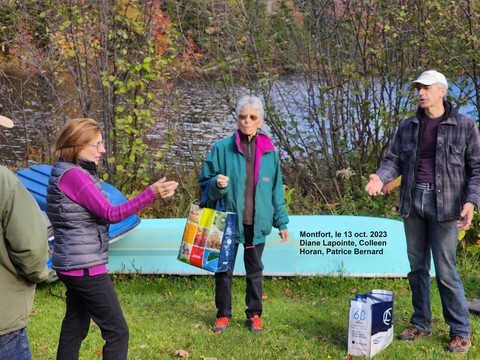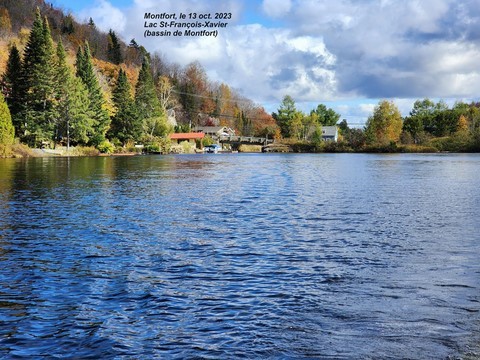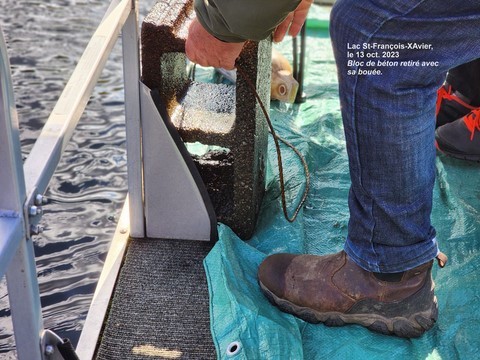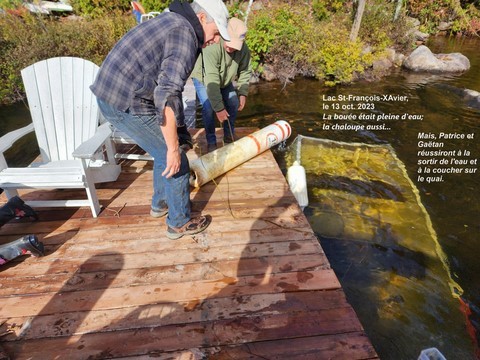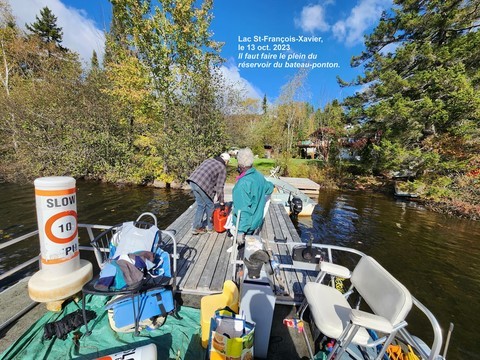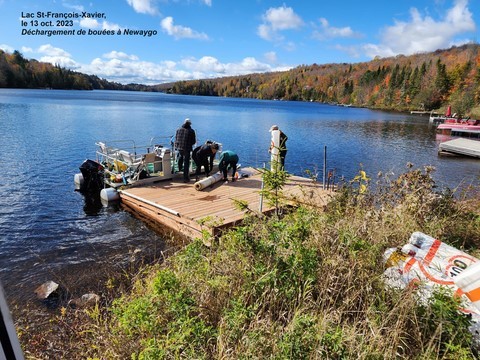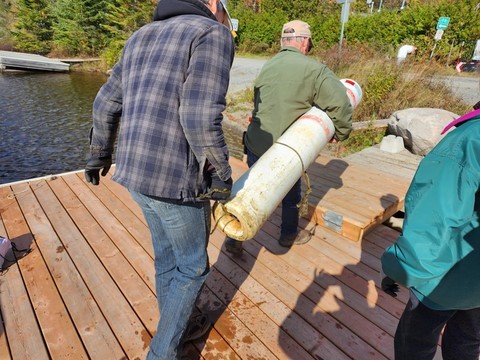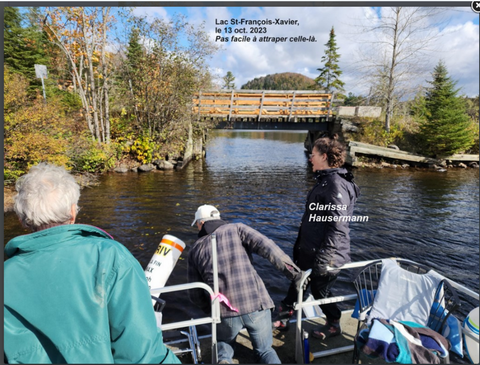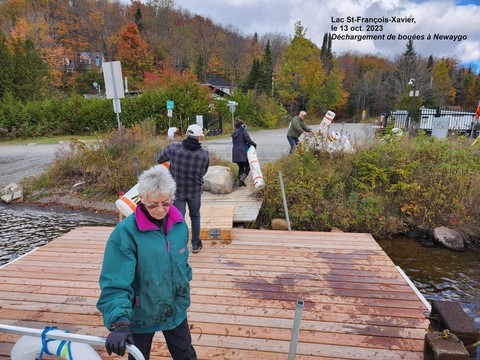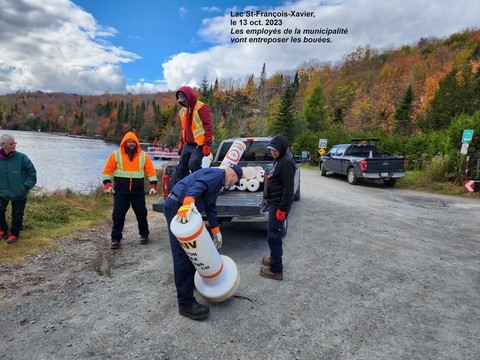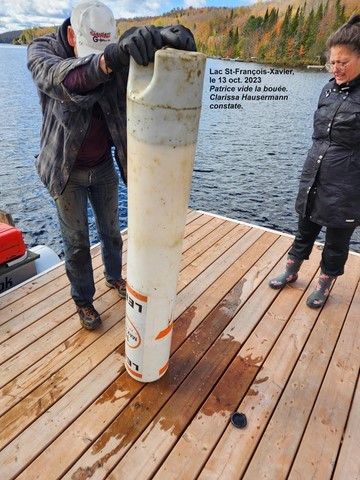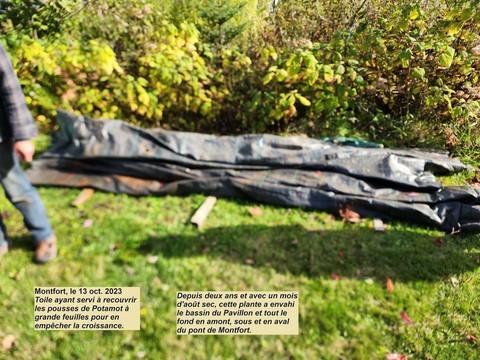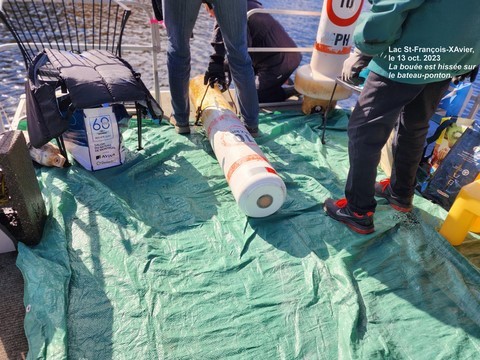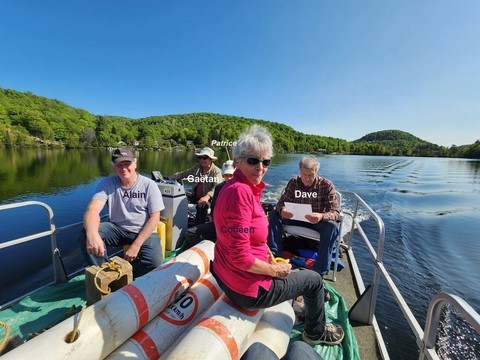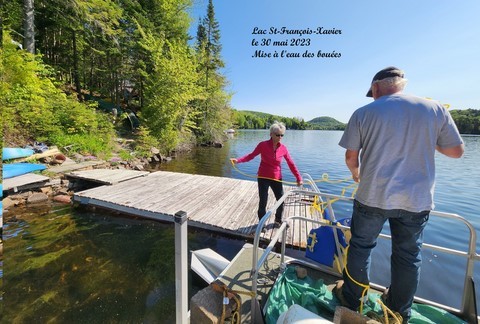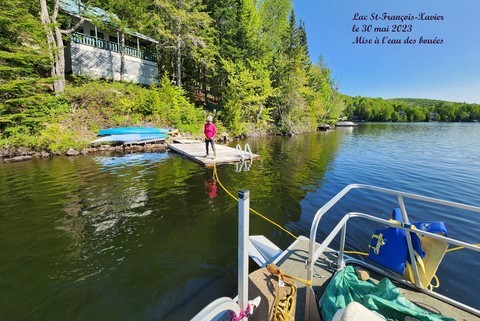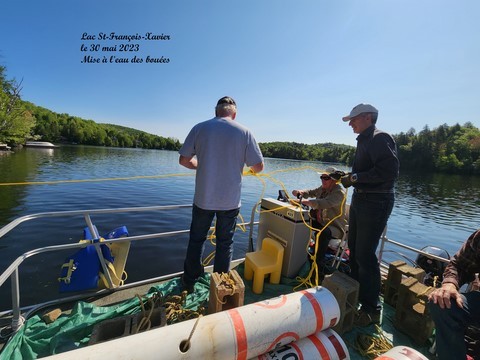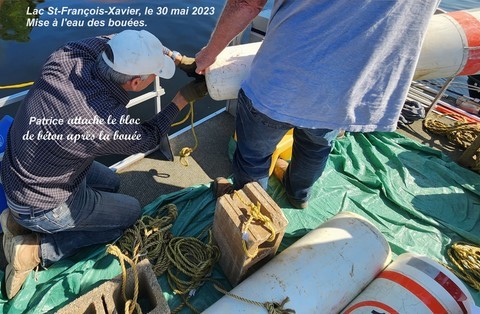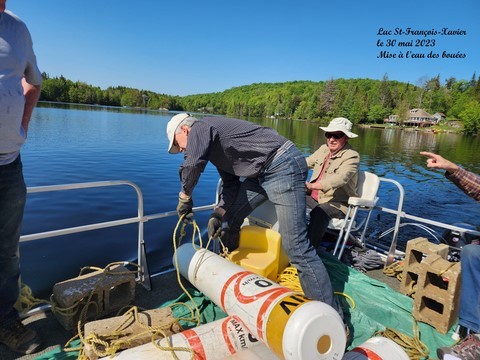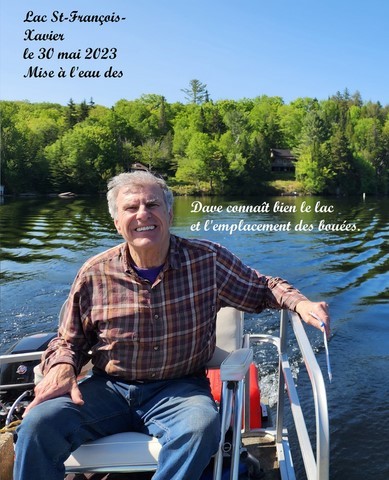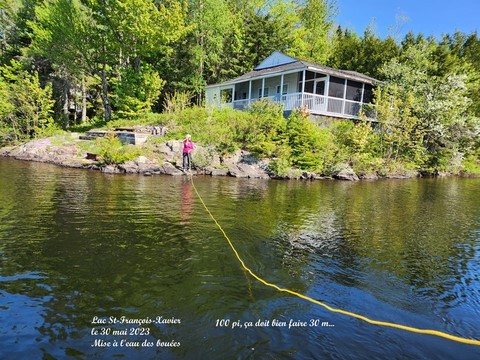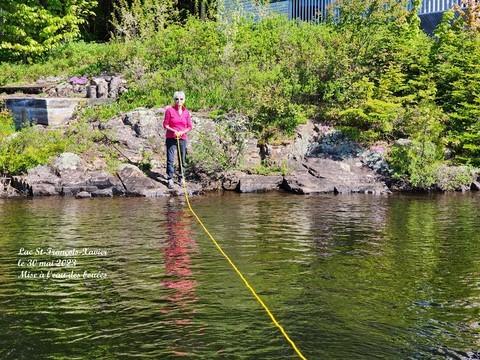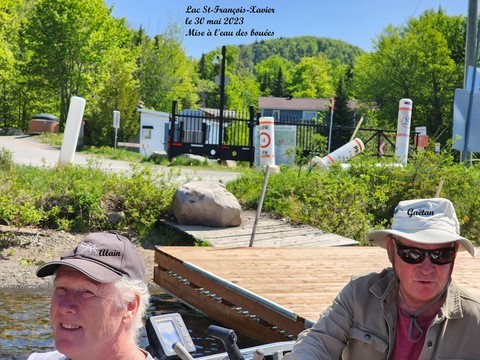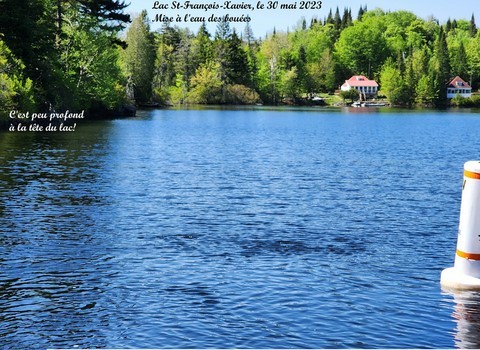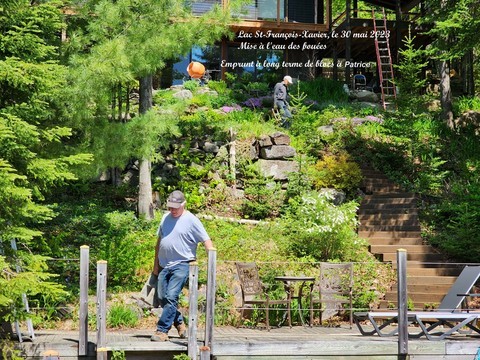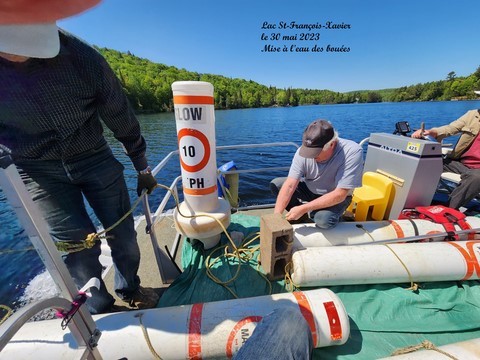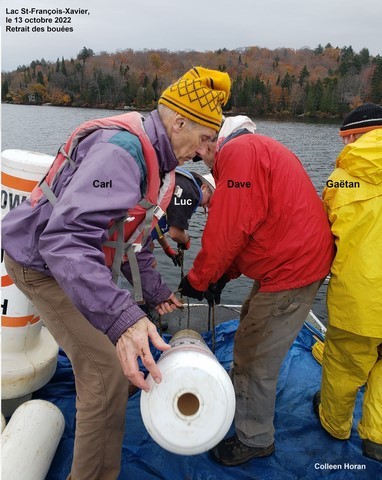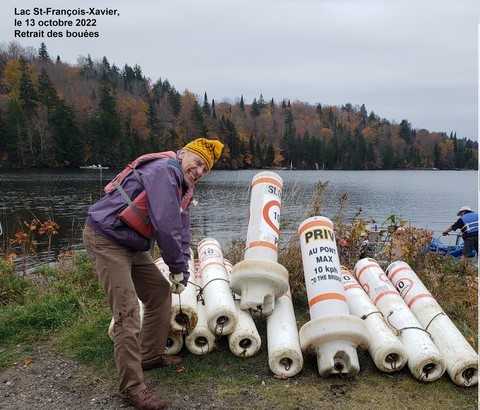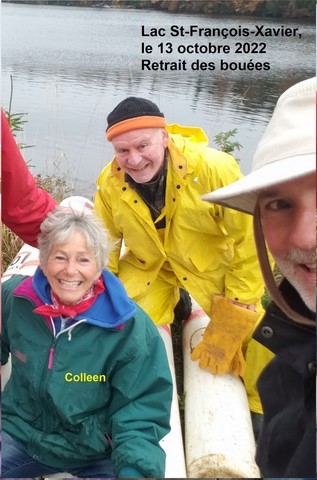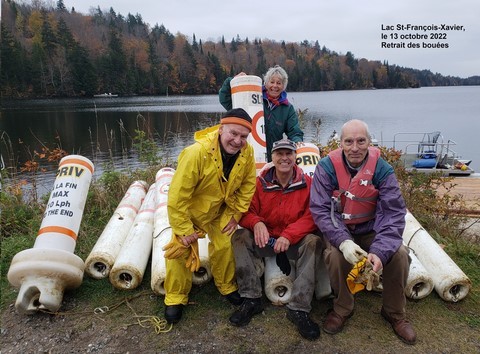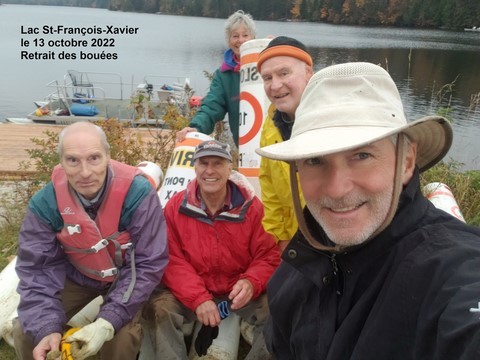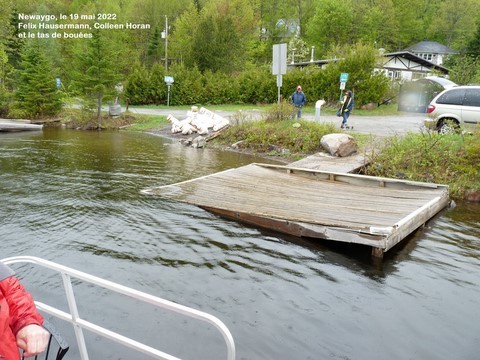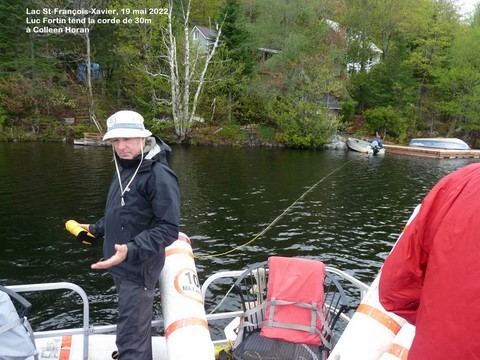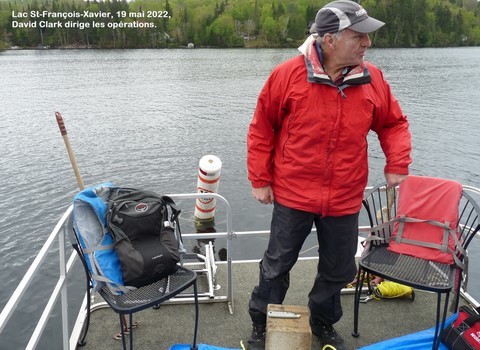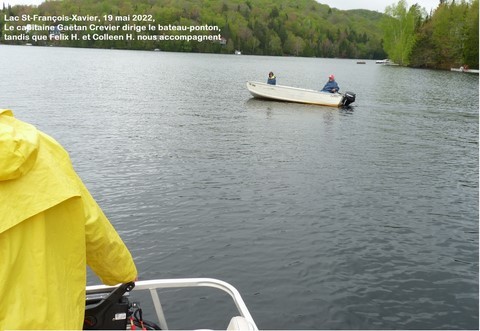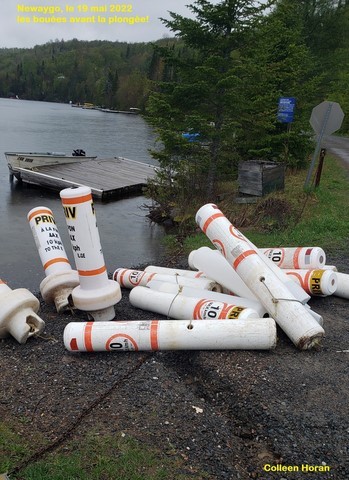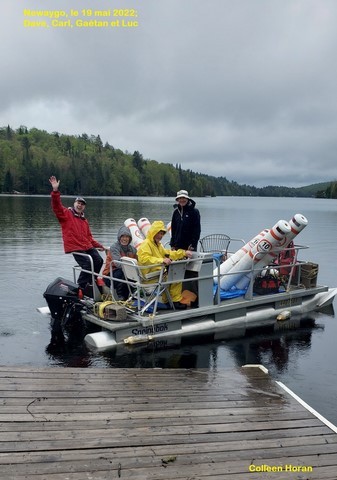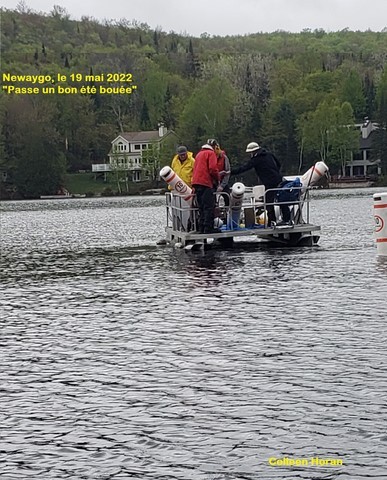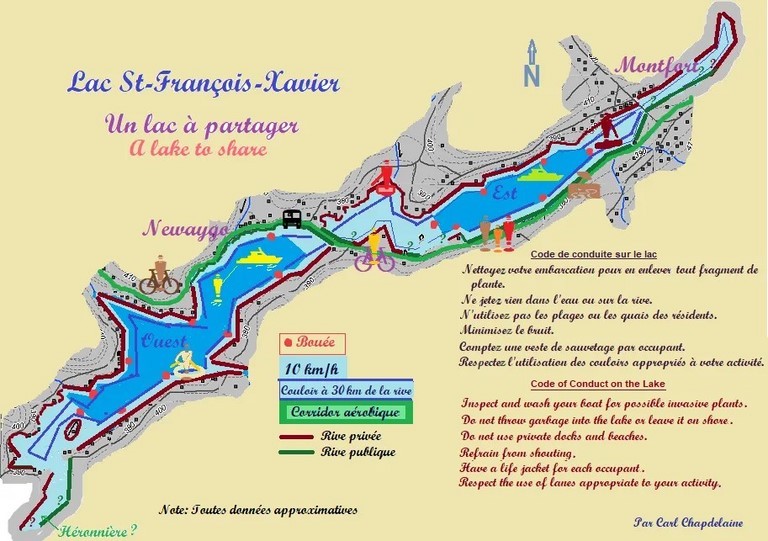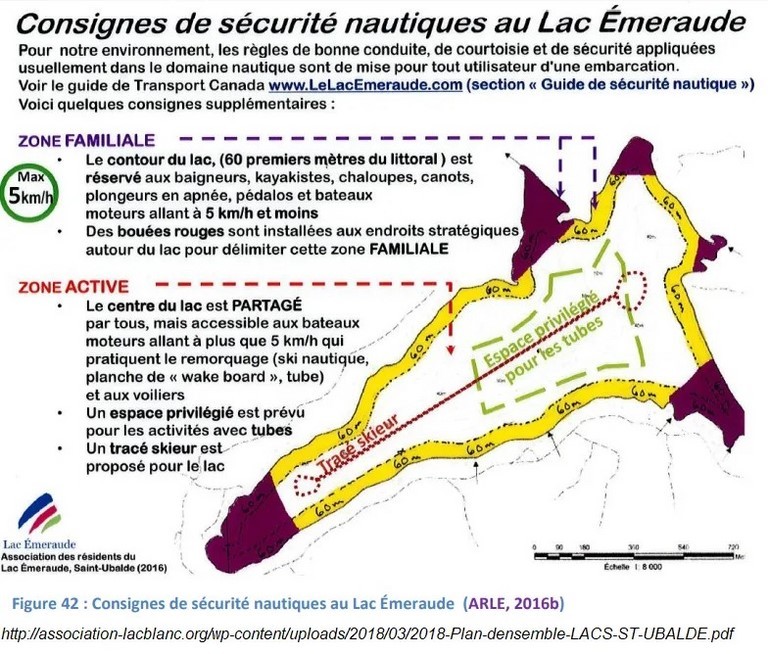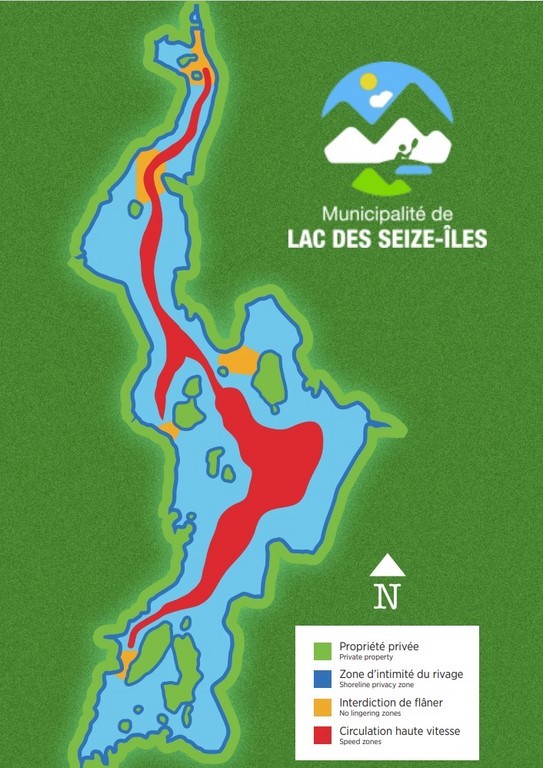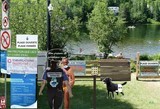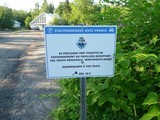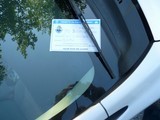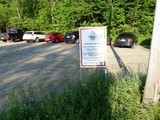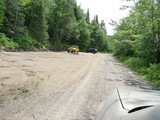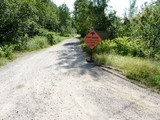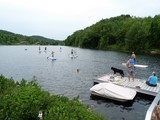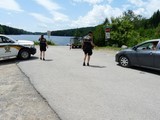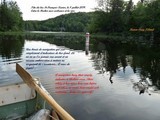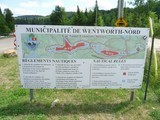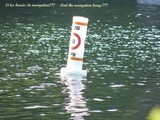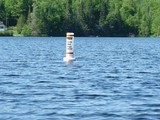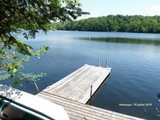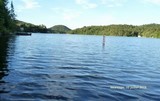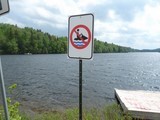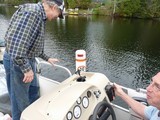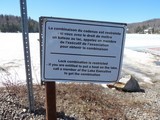Lake access
- Buoys Launching, May 16, 2024
- Buoys Removal on Oct. 13, 2023
- Lake Saint-François-Xavier And Beach
- Launching the Buoys, May 30, 2023
- Buoys removal in the fall of 2022
- Beach brigade
- Buoys at Lake St. Francois-Xavier
- Summer 2022 in Montfort: a global plan?
- A lake to share (map)
- Protective ecotourism?
- Cliche's consultation on parking and the Montfort beach
- Restricted beach?
- Montfort Beach 2021
- Visiting Lac St-François-Xavier?
- Montfort submerged & parking stickers
- Status quo on buoys at LSFX
- Access to the lakes
- Visitors & Eurasian Watermilfoil at LSFX
- Thurson access to the Lake!
- Wear your PFD on the Lake!
- Boating safety in Saint-Adolphe-d'Howard
- The saga of buoys
- Buoys to the water, please!
- The buoys at Lake Saint-François-Xavier
- Code of conduct for paddlers
- Buoys floating!
- Info-Lake maps
- Stand-up paddle board riders on LSFX
- «Our» lake?
- Boat inspection
- Boat wash if...
- Code (boat launch)
- No seadoo
- Location of the buoys, May 16, 2015
- Boat launch: procedure + Craft cleaning
- The Newaygo Barrier
- navigation bylaws
- Caution on water
Plainte modulée du huard
Buoys Removal on Oct. 13, 2023
Our buoys must be installed in spring and removed in autumn. They also seem to have a useful lifespan before they have to be replaced. Not to mention the fact that some of them have simply disappeared! These characteristics bring their own set of constraints in terms of volunteer labor and cost to the municipality.
In addition, tracing their location, with the appropriate length of rope for the depth separating them from the lake bottom, remains a problem. We had started by leaving the concrete blocks holding them to the bottom for the winter and attaching a small buoy to their rope to find them in the spring. But the ice would probably move them at will.
Now we're talking about four-season buoys, unique in the world, installed in the St. Lawrence River to replace the seasonal ones. "They can withstand very severe ice conditions. The ice flows around the buoy or, in the worst conditions, tilt the buoy and flow over it. When the ice recedes, the buoy returns to its upright position."* Their cost, however, seems very high. When can we expect a buoy like this for Lake St. François-Xavier?
*Canadian Coast Guard; Canadian Coast Guard
Lake Saint-François-Xavier And Beach
Lake Saint-François-Xavier has only a tiny, unsecured municipal beach. A few dozen bathers, at most, can find a place there. Because of the large number of visitors, it has been reserved for residents since 2020.
The launching of boats and others, as well as parking, is controlled by a system of stickers. This procedure also limits the possibility of obtaining one of the three dozen parking spaces that are available.
The municipality has had to create a constabulary to ensure that these regulations are respected and that order is maintained on its territory.
With all due respect, by Carl Chapdelaine
Translated with www.DeepL.com/Translator (free version) & Linguee
Buoys removal in the fall of 2022
A phone call from District 5 Councillor Colleen Horan the day before the operation, and it was the small weather window that shouldn't be missed. It would still be fairly mild, maybe 15 degrees or so, but heavy rain was forecast for the middle of the day. At 8:30 a.m., the team of volunteers, Dave Clark, Gaëtan Crevier, the pontoon boat captain, Luc Fortin and the undersigned, who had launched the buoys on May 19, set out again on a well-orchestrated tour, under Colleen's supervision. Upon questioning, the councillor admitted to having slept poorly that night. (God or the only master here after God, must have known why...) It would all be over by noon, she promised. The undersigned, like Dave and Colleen, were veterans of this operation. The latter two had the advantage of knowing by heart the usual location of the buoys, with the name of the nearest resident, which would allow any old resident to locate it on a map in memory.
Attention, it was necessary not to lose the head; that was at the passage under the bridges of Montfort and Newaygo. As we approached the latter, we noticed the advanced state of decay of the beams at the base of the stack of decreasing length towards the top of this wooden structure. Fortunately, the concrete blocks that now guarantee the closure would not allow a concrete mixer to enter; the whole thing would have seemed to us to collapse like a house of cards. With its impressive concrete base, the Montfort bridge is of a completely different order of solidity. It is rather under the hull of the boat that one must look, to make sure that it does not touch the bottom, formerly two meters lower in the channel.
Luc Fortin would pull the buoys out by force of arms; helped by Dave who would pull them up on deck and manage to detach them from the concrete block that Luc would also have to pull out. The underwater section of the buoy was covered with a slimy layer of organic matter that made it slippery and very messy. You had to be considerate enough to dress accordingly. The use of carabiners, however, was a definite improvement over the previous chore of having to tie or untie the rope or chain after the ring, in the cavity under the buoy. The space was already too small there to allow more than two people to work together. After removing half of the buoys, they would have to be delivered to the rebuilt Newaygo dock to make room. The weight of the two men, the blocks and the buoys would eventually bring the bow of the boat too close to the surface of the water and prompted the captain to confine the undersigned and Colleen to the stern.
Colleen, with the help of yours truly, cleaned the buoys, while carefully identifying each one with its concrete block and recording its location on the lake. In the future, it is hoped that this will eliminate the need to measure the length of rope needed to get the blocks to touch the bottom exactly when finding their location. Some of the ropes were worn from rubbing against the edges of the blocks, almost to the point of breaking. One buoy was taking on water and would have to be replaced; another, in equally bad condition, had already been towed to shore, and its concrete block left on the lake bottom. The plastic sheet, bearing the inscriptions and glued on the three new private buoys, in the shape of chess pawns, was prematurely deteriorated. (One can imagine the anger of the Executive of the Lake Association if it were to read Max. 1 instead of 10 km when approaching a shallow area...) Other buoys should have their reflectors replaced.
Occasionally, Gaëtan, with his eye on his depth sounder, indicated the depth of the lake; here 40 feet, here 25. From this pontoon boat, its two basins seemed immense; much more than aboard a simple rowboat; it was really a jewel and a privilege to live there.
The scenario unfolded so smoothly that by 10:15 all the buoys and concrete blocks were piled up on the shore, where Colleen would see to their removal by the municipality. The rain could start, and it did... We'll see you at the beginning of the next season.
Translated with www.DeepL.com/Translator (free version) & Linguee
By Carl Chapdelaine
Beach brigade
The construction holiday is soon upon us (22 of July to August 7) and I anticipate a large number of tourists visiting our lake St. Francois Xavier in Montfort. The washing of boats is well organized and I see that the Municipal employees are doing a good job. We have washed a large amount of boats already but the beach (public access) area is the most vulnerable. I have witnessed and stopped a few boats from embarking at the beach without their boats being washed.
I propose with the help of the lake Associations, to form a kind of brigade to monitor this sensitive area. If we could ask for volunteers from Wentworth-nord ( all villages -St. Michel and Laurel ) to help monitor the area, that would be great . My idea is that there be 3 shifts a day for 17 days. 3 hours from 9 to 12 , 3 hours from12 to 3, 3 hours from 3 to 6pm, for 17 days would mean 51 people to cover the beach. Each person would just monitor that no watercraft entered the beach area and direct the people to the boat wash area. Each shift would wait for the next person to relieve that person.
Our constables would also be available at times and if there were any difficulties we would have a number to contact them. I find this is the only solution that is available to us at the moment so as to be proactive and protect our lake and sensitize the visitors. It would also prepare us for future development and public access around our lakes.
Please send me your thoughts and your interest in participating so that we can go forward with this. Call me 450-226-3214 or email me colleenhoran01@gmail.com
Colleen Horan
Concillor, district 5, W-N
Buoys at Lake St. Francois-Xavier
Let's resume our presentation of the issue of the federal regulations on speed limits, restriction zones and schedules for the practice of motorized water sports on Lake St. Francois-Xavier and on the installation of buoys that allow the Sûreté du Québec to control their application.
The regulations are intended to ensure the safety of users and are, according to the competent bodies responsible for protecting the environment of waterways, an adequate measure to protect the lake itself. The SQ also ensures that other navigation and safety regulations are respected when it occasionally patrols the lake. This is an asset, even if you don't want to be caught out yourself. A comparison with speed control on the roads around the world shows the value of such regulations. The current executive of the Lake Saint-Francois-Xavier Association, however, disagrees with the installation of the buoys, citing various reasons:
o the danger they pose to the moving boats themselves;
o the impossibility of determining the exact 30 m limit of a cut shoreline;
o the displacement of buoys caused by current, wind or other conditions;
o its survey would show that the majority of residents are against it;
o etc.
These conditions exist at the main lakes of Saint-Adolphe-d'Howard, and everywhere in Canada where the same regulations apply; the latter most often extending to the whole province. (Status Quo On Buoys At LSFX) Here, as in other lakes where it exists, it is true that the regulations apply with or without the installation of buoys; but their control becomes visibly hazardous in latter case. The former administrations of the Association had obtained it after a decade of arduous negotiations with Transport Canada. The Buoys At Lake SFX
During the election campaign, the current municipal administration promised to put all the buoys back in place at the lake. Yesterday, May 19, a small team of volunteers, disassociated from the Lake Association, proceeded to install a dozen buoys. Only two of these mastodons, deprived of their reflective tape, could not be put back in the water yet. The success of the operation, despite the gloomy weather, should be welcomed without reservation.
In our opinion, the recriminations of those opposed to this regulation or its application must be taken into consideration to ensure that any counter-indications are minimized; this is all the truer since they come from the Lake Association. Is there really a need to divide a community over this issue when, as the Lake Association survey points out, there are many other priority issues at the lake?
Yesterday's operation, overseen by Councillor Colleen Horan and reminiscent of all the previous ones, has always been a volunteer effort and poses many challenges. Due to a lack of insurance, it cannot be done by the municipality.
Technically, it is impossible to determine the exact location of the buoys on the water. Transport Canada had provided us with a plan that delineated a 30-metre strip along the shoreline on paper. It seems that the location of the buoys was also suggested, but not imposed. Only the distance had to be respected. But the buoys are held at the bottom of the lake by a rope anchored to a concrete block. At the surface, and depending on the length given to the rope, the result can only be approximate.
GPS tracking, which we initiated in May 2015, is only intended to facilitate the annual repositioning of the buoys. Removed with its concrete anchor in the fall, and identified with its number, each buoy, with its rope of good length, could theoretically find its place in the spring. This should make the whole operation easier, and even more so if, equipped with an appropriate GPS, the pontoon boat that carries them can set a course directly to the identified location.
With all reservations; by Carl Chapdelaine
Translated with www.DeepL.com/Translator (free version) & Linguee
Summer 2022 in Montfort: a global plan?
The influx of visitors over the past two summers and the seemingly intractable problems it brought to Montfort and elsewhere in the Laurentians is now distant memories. In the Wentworth-Nord municipal election, the promises of the two opposing groups seemed to point the way to solutions. And why not make a non-partisan choice from these promises today?
But, 2022 is just around the corner; the pandemic drags on. On the chessboard of the summer invasion of visitors looking for nature, outdoor escapades, freshness, water sports and swimming, and therefore lakes, and while the hourglass is pressing us to play, we do not see the necessary advances taking shape. Will we have to relive the same nightmare in 2022 and forever?
In Wentworth-Nord in 2020 and 2021, the problems may have surprised an already divided, if not opposed, council on the remedies. But the key measures taken seem to us to be the beginning of some control of the situation. The vignette system was developed. A constabulary has been set up to enforce local regulations; but, more precisely, what regulations and how? And the run-in to the unit may have brought its share of glitches. However, the Aerobic Corridor, the Montfort Pavilion, the beach, the parking lots, the bill; nothing seems to be settled yet or even in the process of being settled.
Negotiations with the MRC, with which Wentworth-Nord shares jurisdiction over the territory in Montfort, have been deemed essential to finding a solution. Interrupted by a reluctant council of mayors, it is expected, according to the mandate just given to the director general of the municipality, that they will be relaunched shortly. But we should not expect any miracles from these negotiations. And, in the face of invaders, transforming Montfort into a fortress is not an option; nor is it likely to be negotiable.
Part of the problem goes beyond the scope of municipal structures. It is more global; it is at least on a regional scale and requires a longer term vision. A piecemeal response will not solve it, as one David Clark pointed out. Protective Ecotourism?
And will the situation, brought about by the imposition of containment and other implications of Covid 19, really disappear with the control measures to be applied or the end of the epidemic? Is this not a foreshadowing of what is to come? At eighty kilometers from Montreal, can Montfort really escape the tourist vocation of the Pays-d'en-Haut? With a strategy, at least at the level of the MRC, should it not rather prepare itself for this? There is a metropolis, ever more populous, and its tourist region where nature calls. And, at the same time, there is a conflict between the inhabitants of the one and the other; for it is an environment that one can, or wants, or cannot or does not want to share.
For us, it is necessary, among other things, to direct part of the flow of visitors from the south to where space and nature await them. The metropolis would need a sort of Gatineau Park, largely grafted onto the Laurentian territory of hills and lakes. Wouldn't this park include federal, provincial, municipal and private lands? As with the designation of a greenbelt around an urban area, the establishment of such an entity "and its administration involves ... some form of cooperation between the levels of government involved and local governments. For example, in the Toronto area, the greenbelt stems from provincial planning that dictates what activities can take place there."
"It's a consensus: we don't live in ideally planned communities. ... The residents of Montreal's North Shore ... know something about that." Alliance ARIANE
But all of this needs to be part of a national land-use policy; a request to Quebec that perhaps the Council of Prefects and Elected Officials of the Laurentian region should add to its list of priorities. https://prefetsdeslaurentides.ca/
On the related issue of urban sprawl and land protection, Montreal Mayor Valérie Plante regrets that there is not more coordination between cities in the third ring, such as Saint-Jérôme, and the metropolitan agglomeration. The latter has a metropolitan land use and development plan (Plan métropolitain d’aménagement et de développement - PMAD). "All the municipalities in the CMM are quite willing to work with the municipalities in the surrounding area." "We need the Quebec government to be part of the discussion." Plante veut freiner l'étalement urbain
We can imagine the headache and the brawl that such initiatives would trigger. But from the government that should be looking at avenues, only the steam that we want to believe is coming out of the pot, as with the environment, transportation and many others, gives us hope that it is working on it. Has the pandemic so mobilized or limited resources that the rest no longer merits attention? That's assuming there is even an awareness of a problem and attention to it.
More:
- https://ncc-ccn.gc.ca/places/gatineau-park
- Greenbelt master plan
By Carl Chapdelaine
Protective ecotourism?
On Wednesday, March 10, Councillor Cliche, flanked by his colleagues David Zgodzinski, Eric Johnston and Yvon Paradis, consulted Montfort residents on the hiring of constables for the 2021 summer season. The consultation allowed the municipal committee in charge of negotiations with the MRC, concerning the village and Lake Saint-François Xavier, to have a range of their views.
The wave of interest generated by this exercise has continued to feed the e-mail chains that serve as a medium of expression and information here. There is no doubt that the authorities now have in hand multiple data to support their various and sometimes opposing arguments.
The last of these chains highlighted the idea of a newcomer on Chemin-de-Fer Street who simply proposed to prohibit access to the lake to any type of boat from non-residents. Wasn't the whole business of stickers, parking vouchers, etc., which Municipal Council and others were working on without any concrete results, too complicated? Wasn't the protection of the lake and the right of its residents to enjoy it in peace and safety worth simply banning access to it once and for all? Justification? Perhaps; but did she not forget that these residents were too often on the list of offenders. And who can legally issue such a ban?
A lifelong resident of the lake, and above all concerned about the protection of its environment, Mr. David Clark, took the liberty of answering her while placing the problem in a historical perspective. During the consultation, he insisted that we should not limit ourselves to the search for specific solutions to recurring problems, but that we should insert them into a global approach to the situation of the village and its lake. Without further explanation, it was difficult to see what he was getting at.
He recalled that the Aerobic Corridor Park runs along the lake for more than half of its length; that it is provincially owned; and that its ecotourism vocation will certainly not have to change. He explained that the current and continuing influx of visitors was perhaps a lesser evil than that which would result from the absence of the Corridor.
The railway had once been converted to a greenway, when it could have become the 364, and a municipal plan even called for it to be a forestry road with residential development along part of its route. Would the government have an interest in keeping an Aerobic Corridor whose low use, beyond the village of Montfort, would no longer justify public investment? It could well abandon it to developers.
Then, let's assume, it would become exclusively Chemin-de-Fer Street, the road, currently shared, would no longer be a dead end; but perhaps a connection to the Route Principale.
In conclusion, Mr. Clark pleads for a more global approach to the situation; for an evaluation of all the issues of ecotourism and for negotiations in which the parties do not remain camped on their position. He told us earlier that he sees simple and inexpensive solutions that do not involve regulations, constables to control them, or restrictions for all of us. Resident participation, information and action planning were among them. And this time, he was putting a preamble to it that would perhaps help us understand his point of view.
The linear park of the P'tit' train du Nord has brought the villages it passes through, such as Val-David, to regain the tourist traffic necessary for their survival. Logically, Montfort could, in the same way and with this influx of visitors, recover its former vitality, when it competed with Morin-Heights and Saint-Sauveur; with its three stores, its three country clubs and its two dance halls besides the hotels. If the residents of the village and its pristine lake do not want to see the same kind of development, would it not be to their advantage to ensure that the Corridor keeps its status as a regional park rather than risk becoming a forestry road and an urban thoroughfare to be developed? Near the metropolis, can't the exceptional Lake Hertel on Mont Saint-Hilaire remain protected only by virtue of a similar status for this mountain?
But to imagine the long-term development of such a scenario seems to us to be risky. Its short-term local economic benefits would not justify it. However, the attraction of such an oasis could only accentuate the pressure on the periphery of the reserved area; a good deal for real estate developers and the municipality. The chessboard on which our negotiators are battling is full of pitfalls. Who can see the final repercussion of the movement of any pawn? Where are the examples to follow or to avoid?
In the negotiations that are beginning between the spokespersons of the residents and those of the authorities, whose motivations are sometimes contradictory and even if they may sometimes be the same representatives, should we not put everything on the table and a little water in our wine?
Translated with www.DeepL.com/Translator (free version)
By Carl Chapdelaine
Cliche's consultation on parking and the Montfort beach
Councillor André Cliche spread his consultation over two sessions by videoconference, one in the morning of March 10, 2021, the other in the evening. There must have been about twenty participants in the morning and almost as many in the evening. Councillors David Zgodzinski, Yvon Paradis and Eric Johnston joined Mr. Cliche in the morning, and Mr. Paradis again in the evening.
In his invitation, Mr. Cliche had already indicated his approach: "...I am not against recreational tourism activities, especially because they have provided public trails that benefit the entire community of Wentworth-Nord and in theory, these activities should generate positive economic impacts for Wentworth-Nord." His colleague from the Montfort district, Mr. Zgodzinski, had taken strong exception to such a statement, suggesting that it did not apply here. He was probably expressing the opinion of the majority. The invasion of the village by visitors and, last summer, of its small beach, had provoked a strong reaction from residents.
Councillor Cliche outlined his consultation plan: 1. Identify the issues. 2. Validate the actions to be taken. In the evening, he followed our suggestion to precede his plan with information on the key themes of these issues: the role and powers of the constables; the division of property, jurisdiction and financial burden between the MRC and the municipality in the sector.
Mr. Cliche invited participants to express whatever ideas they had; it was probably better to look at a range of information and possible solutions than to sit on a comfortable position.
For some, the problem and its solution was not limited to the issue of parking or beach access; a more comprehensive view of the issues in Montfort was needed.
But, the two major concerns that would be expressed were: 1. the protection of the residents and, in a way, their right of appropriation of the site. 2. The protection of the lake, i.e. of its environment.
The local stakeholders' observation was that there was too much pressure from visitors during busy periods, and that this constituted a very serious threat to the two concerns expressed. The current pandemic had accentuated the problem; but the popularity of the Pays-d'en-Haut, increased by the impacts of this particular situation, would only grow in the future. It was therefore necessary to work on a long-term solution as well.
Regarding the problem of visitors launching small boats of all kinds, and the risks of introducing invasive species, among others, the president of the Association du lac Saint-François-Xavier, Mr. Raymond Noël, noted that this could take place along the entire length of the Aerobic Corridor, and not just at the two designated sites. Mr. D. Zgodzinski would illustrate this reality by recalling what Mrs. Hélène Chartier, who was in charge of the Montfort Pavilion at the time, told him, and to whose workload was added the control of this bad use. But he did not specify that she also noted that the various offences were mostly committed by residents...
Following these interventions, Councillor Johnston proposed that a by-law be adopted to formalize the obligation to limit the operation to the two designated locations (Montfort Pavilion and the Newaygo boat launch). There seemed to be unanimous agreement on this proposal.
(To allow formal control; this is precisely the argument that should prevail in the choice to put back the buoys delimiting the 30 km of shoreline within which the 10 km per hour limit applies to protect the lake and the bathers. However, the ALSFX is finding every way to oppose this; while receiving the support of the municipal council...) A resident of the village also pointed out that some offenders were going too fast on the lake; that they didn't really care about the buoys. The president of the Fonds environnemental du Lac Saint-François-Xavier, Mr. Robert Théorêt, agreed, stating that the 10 km buoys had their place. There was no control over navigation. (Were they referring to the buoys that have been absent since 2015, after more than a decade of fighting to get them?) One participant said that some boats sometimes even approached the municipal beach dangerously with their engines running.
Regarding beach access, there would be multiple interventions; following which, E. Johnston would conclude, "So, there are some who talk about reserving it for residents; others are willing to share it."
Mr. David Clark recalled that the beach was a trade-off CN had once agreed to with aggrieved residents. (We did not catch the description of the reason.) It was therefore theirs exclusively. (His argument had not convinced the undersigned. Decrees had since been adopted by Quebec so that one could not own watercourses or prohibit access to them. Was the spirit of the law being respected here?)
Others, including the undersigned, could imagine a certain sharing of the privileges enjoyed by the residents for the lake, the beach, the shared lane of the Aerobic Corridor, their environment in general; and that a controlled access to the Montfort parking lots was a solution that should not be ruled out. In order for it to be valid, contrary to what had been the case to date, there had to be adequate municipal constabulary surveillance, and therefore the power to issue tickets not only at the beach or on any other municipal property, but for illegal parking on territory under the jurisdiction of the MRC (parking lots, Aerobic Corridor or regional park).
There also had to be at least a 60%/40% MRC/W-N split in the funding of this constabulary presence; failing that, the entire bill could be passed on to the MRC, as Mr. Zgodzinski advocated. But how to get the MRC to fund a constabulary that would, among other things, and if it were the case, prohibit the public beach to a part of the public, the undersigned will argue. (We thought, as Mr. David Clark would confirm in a subsequent communication, that sweaty cyclists must have taken the time to cool off at the beach as they passed by).
Negotiations between the municipality and the MRC on these and other major issues in a territory under dual, triple or quadruple jurisdiction (+ provincial and federal departments of transportation) were to begin on March 17, with the mediation of the Ministry des Affaires municipales et de l’Habitation (MAMH). With opposing views, Councillors Cliche and Zgodzinski, along with Mayor François Ghali, formed the committee that would represent Wentworth-Nord. Without a common front, how would they be able to win the case in a confrontation where the MRC seems unwilling to yield?
Concerning access to the beach or otherwise, the suggestion of Mr. Cliche and the undersigned, among others, to focus on parking control, possibly using increased means, such as small automatic gates with the obligation to go through the Montfort Pavilion to obtain the appropriate tickets and stickers, was no longer convincing to the district councillor, who had already advocated the use of such stickers himself. He was now strongly advocating the closure of the parking lots. This closure seemed to him all the more relevant since the pandemic was not going to allow, still this year, to see the risks of the visitors' affluence decrease. In any case, Mr. Cliche concluded that priority of use should certainly go to residents.
One participant suggested that, in this age of cell phone use, etc., motorists looking for a destination in the Laurentians and its lakes might be able to check where there is too much traffic and find another destination. (We didn't quite catch all the details of this intervention.)
Councillor Paradis asked the ALSFX President if it would not be appropriate to leave the control of the beach to the Lake Association, did we understood. Disturbed by the proposal, we were unable to grasp Mr. Noël's answer; but there were certainly reservations in subscribing to this suggestion.
Another participant reported that during peak periods, visitors were swimming near the Newaygo boat launch. One participant, reiterating that the beach was for residents, advocated that a beach be created at the Pavilion for outsiders who would find all the related services there. According to her, it was up to the MRC to solve the problems it had created by developing these facilities and promoting Montfort as a tourist destination.
The behaviour of paddle boarders on the lake, who were occupying the central lane used by motorized boats, was also highlighted. The undersigned suggested that the Montfort Pavilion attendants should give the usual recommendations to visitors. (Didn't the lake association once distribute such a leaflet?) Adding a sketch of the areas and properties to be respected on the lake, as is done for other lakes, could easily alleviate the problem. The Echo Aloha Club claimed to be educating their clients on the rules).
One of our Mother Courage thought it appropriate to point out that the municipal council did not always give the required attention to the problems that concerned Montfort. She had read the long contract between the municipality and the MRC for the administration of the Pavilion and related matters that Mr. Zgodzinski had circulated. (What did she find?) Mr. Cliche told her that there was more than one contract, and that the council was taking the situation in Montfort into account.
A newcomer to the lake suggested that the administration of the activities (boat washing, rentals, etc.) around the Montfort Pavilion (and on the relevant portion of the regional park) could be entrusted to a private firm that might be able to profit from it. André Cliche told him that this company existed until the municipality hastily took over the contract in 2018; it was the Coop des 4 Pôles... But this was a page of our history that he did not want to insist on.
Mr. Cliche would conclude by reiterating the points and solutions put forward during the day's consultation.
Translated with www.DeepL.com/Translator (free version) & Linguee.
With all due respect, by Carl Chapdelaine.
Restricted beach?
Councillor David Zgodzinski called on his colleagues and sought the support of residents for the hiring of full-time constables to oversee a reserved access to Montfort Beach next summer and to prevent unwashed boats from entering the lake. Then he talked about passing the bill on to the MRC. In this regard, negotiations on the disputes between the municipality and the MRC should take place soon, he added. No doubt he was referring to the mediation requested from the Ministry of Municipal Affairs and Housing (MAMH), which should begin shortly.
His proposal follows requests to the MRC for the closure of Montfort's parking lots, particularly the two near the beach, on the Aerobic Corridor; and all the more so in these times of pandemic. The Prefect's response was quite clear; it was contrary to the norm for this greenway and he would not agree to it.
In his request, the Councillor had indicated that the formula requiring users of these parking lots to obtain a sticker at the Montfort Pavilion in order to use them, as well as the installation of a fence to prohibit access to the beach had not really worked.
Several Montfort personalities immediately supported Mr. Zgodzinski's demand for the hiring of full-time constables, while emphasizing that it was the responsibility of the MRC to cover the costs.
But, if you are negotiating with someone else on a dispute, aren't you supposed to grant a truce in proceedings related to that dispute? The municipality would hire constables, without the MRC's approval on its assumption of the expenses; then would want to pass on the bill to the MRC? Wouldn't it be better to first obtain the MRC's approval before proceeding?
The councillor also asks that the municipal beach be restricted to residents, and probably for their visit. He pointed out that other villages and towns in the Laurentians have done this. Municipalities elsewhere in Quebec have also invoked the insurmountable influx of visitors to deny them access to their beaches. Quebec, which has ruled on the public character of its waterways, has not budged in these latter cases.
In response to Mr. Zgodzinski's request, Councillor André Cliche, who is also part of the committee formed to represent the municipality in negotiations with the MRC under the mediation of the MAMH, recalls the current status of the measures adopted by the municipality and its theoretical position in the context. He gives value to recreational and tourist activities. He underlines, moreover, that the constables on duty do not have the power to give notices of infraction, which makes it difficult to respect the instructions. He then invited residents to two videoconferences to discuss the file.*
Isn't a functional system of vignettes fairer than the closure of parking lots and the beach to visitors, as proposed by Mr. Zgodzinski, to protect the lake and its beach, while allowing its residents to have a privileged use of it? Equipped with the necessary complements, such as the use of parking tickets, this system seems to us to offer a valid alternative to the avenues suggested by the councillor.
During the meeting of the Council of Mayors, held on March 11, 2020 at the Montfort Pavilion, we asked the question about the possibility of installing small automatic barriers at parking lots located along the Route Principale or near the beach. This would be a one-time investment that would prevent their illegal use. Prefect André Genest answered that offenders always find a way to get through. Except for cyclists, visitors arrive mainly by the Route Principale. Swimmers are not likely to come from Montreal on foot... When stopping at the Montfort Pavilion, motorists should obtain the parking ticket, free or not, necessary to open the gates, and, as is already the case, the essential sticker for launching a boat. A proportion of these permits could be reserved for residents. All that would be left would be the presence of constables with the authority to monitor and distribute violation notices.
And since negotiations are necessary between the municipality and the MRC to bring this scenario to a successful conclusion, why not propose an exchange of barriers? Accept the Prefect's request to restore the most Prestigious one, at the head of the cul-de-sac on Chemin-de-Fer Street (not in winter please...), in exchange for the installation of the three small ones needed to automate the use of the parking lots? This would ensure, by the same token, a certain control of access to the lake at Newaygo.
Translated with www.DeepL.com/Translator (free version)
*Wednesday, March 10, from 8:30 am to 9:30 pm: Zoom
Wednesday, March 10, from 6:30 pm to 7:30 pm; Zoom
By Carl Chapdelaine
Montfort Beach 2021
To warm us up a little in this cold wave, Councillor David Zgodzinski reminds us that the summer season will return and that the beach of Montfort should be invaded again by tourists.
He asked council to hire a constable-week to monitor access all day, seven days a week, to prevent tourists from setting foot or unwashed boats in the lake and thus allow only residents to swim there, while protecting its environment.
The Councillor reminded that "The fence at the beach and the parking voucher system that we tried last year didn't work." and that tickets must be issued to offenders.
The cost of a full time constable would be in the order of $25,000 to $30,000 for the entire summer season. He is "hoping that the council will agree that this is a small price to pay to protect our residents and the lake we all love". He urged residents to seek the support of his fellow council members.
Of course, you will have to get the MRC to pay for everything. Negotiations on the problems of financial responsibilities between the MRC and the municipality must be addressed in the coming weeks, he added, probably referring to the mediation requested from the Commission municipale du Québec.
Ps. Mr. Zgodzinski does not seem to have thought that the time to put all the buoys back in the water, to protect swimmers and other users, as well as the lake itself, would come long before the time to reopen the beach...
Translated with www.DeepL.com/Translator (free version)
By Carl Chapdelaine
Visiting Lac St-François-Xavier?
Visitors arriving in Montfort by car, to enjoy the Lake or the Aerobic Corridor, should be aware that they will have to find a spot at the Montfort Pavilion (the old church at the entrance of the village) or at one of the three small public parking lots nearby. One of these is in front of the Pavilion; the other two are located on the Aerobic Corridor, near the public beach. A parking sticker (free of charge) must be obtained to park there. On weekends, especially if they are three days long, the visitor may not be able to park there.
The minimum fine is $60; towing costs are incalculable. Roadside parking is prohibited at all times on the territory of the municipality of Wentworth-Nord. Two constables have been hired there to see to the application of all regulations.
The small beach is currently closed because of the difficulty in enforcing the physical distance required by the danger of spreading Covid-19.
To launch any boat or floating device, it must be washed (free of charge) at the Pavilion. A sticker is then affixed to the object. Some kayaks, canoes, bicycles and other items can be rented on site. To launch a motorboat using the gravel ramp at the end of Newaygo Road, contact the Lake Association. The latter, however, indicates their opposition to personal watercraft.
In order to ensure harmony between all users of the lake, it is good to respect a code of conduct (available at the Pavilion). Thus, paddlers on boards or kayaks should leave the central corridor of the lake to outboard traffic. The latter must nevertheless give the priority to the former. Boats and their use are subject to federal regulations. Officers of the Sûreté du Québec can monitor compliance with all regulations on the Lake.
Visitors in search of beaches could advantageously continue on the 364 or the Aerobic Corridor by bicycle as far as Huberdeau, some 20 kilometres further on. From there, the Chemin de-la-Rivière-Rouge offers sandy beaches as far as the eye can see on seemingly vacant lots, but no parking in sight. The exceptional attractions of the village of Brébeuf, including the immense beach at the end of this road, will crown your hike. Huberdeau - Amherst - Brébeuf circuit
We do not guarantee the accuracy of this information. The exact rules can be obtained at the Pavillon, the MRC des Pays-d'en-Haut or the Municipality of Wentworth-Nord. For the Rivière du Nord, it will be necessary to contact the MRC des Laurentides.
DeepL used for translation.
By Carl Chapdelaine
Montfort submerged & parking stickers
No; it was not the dam at the foot of the great Lake Saint-François-Xavier that gave way, but rather the capacity of the Montfort Pavilion to accommodate people in these times of heat and pandemic. Councillor D. Zgodzinski informs the Director General of the Municipality, Mrs. Matteau, and the residents of Montfort that he received an emergency call on July 1st from Mrs. Hélène Chartier, who has resigned from her reception position at the Pavilion. Her sister Linda, flanked by a new assistant, also announces her resignation for July 15. She is unable to fulfill her duties with the arrival of too many visitors. Boat washing, parking vouchers for the Pavilion and the beach, kayak rentals and others, physical distancing and disinfection measures required of the premises and equipment to protect the village from Covid-19, surveillance, etc., are all part of her duties. She can't take it anymore!
The councillor, who will notice that even when closed, the beach receives bathers and probably uncontrolled boat launches, says that the safety of the lake (Eurasian milfoil) is seriously threatened, just as the Covid-19 threatens the safety of visitors (and residents). While the announcement of the designation of agents who can enforce the regulations to be applied through the distribution of parking vouchers does not seem to materialize on the ground, he denounces a ridiculous and unacceptable situation. He states that "the Pavilion and all tourist parking lots in Montfort should be closed immediately until a workable solution is found".
(Addition of July 10)
The prefect, Mr. A. Genest, will reply to his e-mail to all the mayors of the MRC that these are not "tourist" parking lots; that people around here have the right to swim and that maybe we should also close the grocery stores parkings, while we're at it..."
Councillor Zgodzinski will reply that this was done in Sainte-Adèle; that Morin-Heights closed its beach to non-residents. He asks that the mayors help Montfort to have all the necessary personnel to ensure that the MRC's tourism business does not jeopardize its safety.
By Carl Chapdelaine
Status quo on buoys at LSFX

Pressed by Councillor A. Cliche, Mayor Ghali finally answered, without reading it, our question on the reinstatement of the 30-meter buoys from the shore (see our notes on the council meeting of June 19). Visibly dictated by the Lake Association, his position has not changed since last year, and his mastery of geometry has not evolved. The primary argument this time is that residents could move them to keep motorized traffic away from them, which, admittedly, has already happened. The side note being that if the Lake Association wanted to install them, it could compensate for the Municipality's inability to do so. The Association did put back in place the buoys delimiting the three sections of the Lake where the speed is also reduced to 10 km / h; a so-called compromise solution. The good prince was generous.
Note of 30 June: Our question will not be reported in the minutes published today.
So, these buoys are being installed across the country and even in Saint-Adolphe-d'Howard; but we don't know or we can't do it in Wentworth-Nord, where bad citizens would like to harm the good captains using their speedboats, some of whom are suspected, without scruples, of having once made some of them disappear... Aren't we leaving out the issue of the safety of swimmers and the recognized impact of the rapid circulation in the shallow areas of the lakes on their environment?
Could the mayor not have simply said that he could not afford to do so rather than continue to get bogged down in a ridiculous argument? The mayor is no longer talking about ruling and establishing a policy on the issue, as he announced last year, suggesting that Lake St. Francois-Xavier was not the only one with this regulation. It is clear that it is the lake association, led by the uncontrolled motorized navigation enthusiasts, that decides.
Let us remember that the president of the ALSFX simply dismissed the issue of buoys at the last general meeting of the Association, stating that it was entirely within the jurisdiction of the municipality. Here, we agree that we are thick as thieves, but we will pretend that it is democratic! The saga of buoys
Translated with www.DeepL.com/Translator (free version) & Linguee.
By Carl Chapdelaine
Access to the lakes
On Thursday, June 11, 2020, in the late morning, we saw no one around the Montfort Pavilion; despite the splendid weather. Yesterday, June 18, at the stroke of noon and with the announcement of the beginning of a long heat wave that will be unbearable in the metropolitan area, the parking lot of the Pavilion had its quota of cars and there were also a few in the second parking lot.
Two teenage girls, accompanied by an adult, were struggling to inflate their kayaks before putting them in the shower. Hard treatment for an unlikely sprig of Eurasian Watermilfoil kept in a closet all winter long. We had ourselves, in keeping with an already well-established habit, asked the sister of the person in charge of the reception at the Pavilion (who has just resigned) if she would not wash our car, but this time to get us rid of any potential Covid-19 virus with the Kärcher. She gave us the usual answer, adding that there might not be much left of us after such a treatment.
We took advantage of this exchange to ask her about how to ensure that motorized boats coming from outside did not carry twigs of the Eurasian milfoil, and whether there was a plan to have their engines drained from the water supply used to cool them. This was the responsibility of the Lake Association," she explained, "and she didn't have the answer. We were reassured that the Association, which is made up of many owners of this type of watercraft, was watching and the Municipality had certainly added a clause to the regulations to ensure that this detail was addressed. That could still have been the subject of an intervention in the very democratic question period of the in camera sessions of the municipal council...
(It has always been with great pleasure that we would meet up with one or other member of the Chartier family when stopping at the Montfort Pavilion to get some information, exchange greetings and jokes; without forgetting often more serious discussions on the situation at the lake).
When we asked for an explanation for this increase in visitors, the answer was: the sudden excitement about the gradual end of the confinement; the impression that all danger had passed; and their immense thirst for the water of the Laurentian lakes. Echoes of this attraction to the region had already been noted in recent statements by municipal and other representatives, since the lifting of the barriers and the ban on traffic between the Laurentians and other regions.
We were also beginning to suspect that this phenomenon also explained the increase in visits to our web site, particularly under the headings: Access to the lake and Lake Saint-François-Xavier. Nearly two hundred visits on Wednesday and 123 on Thursday; figures that we thought were probably due to some statistical error. But the information we have developed there may not be of such a nature as to attract them to this jewel. We also learn that the order for swimming pools is currently expanding rapidly.
Meteorologists often remind us that the planet is getting warmer; that we will see more and more of these heat waves here; that records for their heat and duration will be broken as we go forward in the years to come. At the same time, access to the lakes is becoming more and more difficult, if not impossible, for outsiders, while conflicts between those who defend them and local municipal authorities are increasing. The latter, who probably reflect the wishes of a majority of their residents, are posing more and more obstacles for them. Abrinord, little known to the population but very knowledgeable and skilful in interpreting these situations, gives us a well-balanced description of them. Abrinord
The Association des Pêcheurs Sportifs du Québec (APSQ), "in pursuit of its main mission, which is to make public bodies of water accessible to all", is constantly demanding access to the lakes and is taking legal action against certain municipalities, whose tactics it denounces as contrary to the law on access to the lakes or its interpretation. Association-des-Pêcheurs-Sportifs-du-Québec
The media followed: "Only one hour from Montreal, Saint-Hippolyte has 62 lakes. But this aquatic paradise in the Laurentians has only one public access, the small beach on Lac de l'Achigan. And even more: it is only accessible to the 10,000 Hippolytois, proof of citizenship to prove it. On hot days at most, the neighbours of Saint-Calixte, for example - 20 km away - are accepted" Radio-Canada But there are still beaches open to visitors. List of public beaches in the Laurentians: Tourisme Laurentides
And if the non-resident cannot find a place to swim in any of the lakes in the Laurentians, can he or she at least keep the right to admire them, as the Aerobic Corridor allows them to do? The situation is not unique to Quebec, of course. Shorewalk, Ontario
Do we not see that the issue of access to the lakes is becoming more and more of a critical issue? That the government and local authorities need to look seriously at the issue; and that a search for sustainable solutions is needed? The government? Yes, according to the Sport Fishermen's Association, which wants to remove the role of municipalities from the debate because it says they have a conflict of interest in this regard, guided by the will or even the dictates of their residents. We can see here that the decentralization of powers to the municipalities is not unanimous, and that many people want the highest authorities to keep control anyway.
Translated with www.DeepL.com/Translator (free version) & Linguee
Par Carl Chapdelaine
Visitors & Eurasian Watermilfoil at LSFX
On January 22nd, the Lac Saint-François-Xavier Association issued a letter inviting residents to enjoin the MRC des Pays-d'en-Haut to counter the threat of the introduction of Eurasian Watermilfoil by careless "tourists". "The extra tourist parking lots located near the beach in Montfort are often used by tourists to put unwashed watercraft in the water. At the November meeting of the council of the mayors of the MRC des Pays-d'en-Haut, the councillor for Montfort explained the risks of Eurasian Watermilfoil invading LSFX via these unwashed boats, kayaks, paddleboards, etc."
These two parking lots, the letter states, are not visible from the Montfort Pavilion where the attendants can keep watch and see to the washing of the boats. The ALSFX invites residents to send an email to all the mayors of the MRC council asking them to close these two parking lots and to send a copy to the regional newspapers. Or, if the MRC refuses to do so, "to please urge these officials to allow the Municipality to charge a fee for parking for non-residents of Wentworth-Nord. Parking vouchers would be obtained at the Pavilion and thus every visiting car could be examined and those with watercraft told to wash them (for free) before putting them in the lake".
The Association adds: "The MRC has a stated goal of increasing tourism as much as possible. Unfortunately, their slack practices regarding the washing of visiting tourist watercraft are reckless. The council of mayors was advised of this danger months ago, but there has been no movement to solve the problem – even though simple solutions have been proposed."
A copy of a letter from the municipal district councillor, Mr. David Zgodzinski, in both languages and clearly addressed to the MRC, is attached to the Association's mailing to residents. The councillor describes the situation in detail, while criticizing the MRC for taking an enormous risk for the environment of Lake St. Francois-Xavier by promoting tourism.
"The Pavilion is the centre of tourist activities that the MRC promotes in our region. The MRC also signed a long-term lease with the MTQ for a territory including four tourist parking".
"During a hot summer weekend day, there are more than 100 cars entering and leaving these four parking lots, bringing hundreds of tourists to our village. They come to cycle, hike or use Lac Saint-François-Xavier for boating."
"You are all aware of the dangers of the Eurasian Water-milfoil - the destruction of the ecosystem of many of our lakes due to this threatening invasive species. To defend Lake Saint-François-Xavier, the municipality of Wentworth-Nord paid over $ 30,000 for the installation of a boat washing station at the Pavilion."
"But unfortunately, some of your guests are not aware of the seriousness of the danger of Eurasian watermilfoil."
"These people generally use the parking lots near the beach and drop their kayaks or paddleboards directly into the water, without going to the Pavilion, because they do not want to bother to wash their boats."
"All of these risks of contamination and destruction of Lake St-François Xavier now rest in your hands, you the MRC."
"I therefore propose some solutions for the MRC in order to reduce the risk of a … disaster occurring."
"One possibility is to place security guards on the two parking lots near the beach. But these guards should be on duty twelve hours a day, seven days a week throughout the shipping season. Otherwise, there is always a risk of contamination of the lake."
"Another possible solution is to let the municipality manage the parking costs. I know that Mayor Ghali told you about our municipality's resolution to charge tourists for parking. We propose to charge a small amount, say $ 5 to $ 10 per day. Anyone who wants to park will have to pay and get their parking voucher at the Pavilion. At the same time as they pay for parking, staff at the Pavilion will ensure that visitors' boats are washed."
"We will patrol the parking lots and give tickets to those who do not comply. This system could work very well by ensuring that tourists stop at the Pavilion."
"The simplest and most effective solution would be to close all of Montfort's tourist parking lots when the lake is not frozen. At the very least, parking lots near the beach should be closed."
"This risky situation must be corrected before March 1, 2020. The MRC cannot continue to put at risk the ecology of this magnificent lake and the lifestyle of the people who live there."
In our opinion, the danger, and even the disaster, anticipated by ALSFX, Mayor Ghali and Councillor Zgodzinski are very real, and the means put in place to deal with them are still insufficient. But to blame the MRC and its "guests" for all the wrongs seems to us to be abusive; whereas the greatest risks of spreading the invasive plant may come from the guests of the lake residents themselves. The shared moral responsibility of the MRC does not seem to us to be in doubt; even if we could not expect, only a few years ago, that the Eurasian Watermilfoil would upset all scenarios. The urgency to act within the means at hand or with the help of Quebec could also dictate the path to follow. We would also like to hear the MRC's version of the accusation of negligence against it.
The availability of parking spaces, or rather their absence, has already been invoked as a practical remedy to block access to the Lake for tourists. The prestigious barrier could also be seen as a radical means of controlling this access. But the solution proposed by the Lake Association and the city councillor to close the parking lots seems morally unacceptable to us. Swimmers, cyclists, walkers from elsewhere, and even the residents themselves who are too far from the beach or the Pavilion when they want to attend major events and no longer have parking space, would also be penalized; just think of the bonfire at the end of the Montfort Regattas.
On the other hand, paid parking, with the obligation to go through the Montfort Pavilion, seems more ingenious and fairer. Would not a simple sign indicating the amount of the fine to which offenders would be liable during their hike on the lake already be a strong deterrent? Ms. Danielle Desjardins would make it conditional on the installation of automatic gates, such as those at the entrance to hospital parking lots, and for which a ticket would have to be acquired at the Pavilion if a resident does not have a pass. And, in our opinion, this addition would be less costly in the long term than putting guards on site. Moving the two parking lots indicated next to those of the Pavilion, she adds, would also address the concerns mentioned. And that, we emphasize, while reducing vehicle traffic on the short, busiest section of the Principale.
However, isn't it troubling to find here the same motive, the same actors, and to suspect the use of methods almost similar to those used to remove the Coopérative des 4 Pôles from the territory after the last municipal elections? Before the latter, was it not also to the municipal council that they addressed their threats for the same reason; before finding themselves spokesperson or seat on it? Are we not here still also trying to stir up the population against the actions of the MRC, while at the same time, as the denunciation of the tourist promotion indicates, aiming to transform Lake Saint-François-Xavier into a private estate? And who, from the MRC or the Municipality, is refusing to cooperate here? Do the people of Wentworth-Nord want to see useless cockfights and perpetual election campaigns, or do they want to see answers to the problems?
We have already hypothesized in the past that long-term solutions, for this lake as for several others that are also at risk, should be developed at the highest level. Tourism, like the general population, will only increase in the future. Should we not, for example, come to designate the lakes to be protected as inhabited reserves and apply some of the regulations that affect our national parks? Boat rentals would take precedence in such a reserve. Rather than seeking by all means to deny access to visitors, quotas for lake use would be introduced through a sticker system, as is already in place in Wentworth-Nord.
Should not the Government of Quebec and the Minister of «de l’Environnement et de la Lutte contre les changements climatiques» (MELCC), Benoit Charrette, in this year when he must put into action the fruit of his department's reflections, give priority to this issue?
By Carl Chapdelaine
Translated with www.DeepL.com/Translator (free version)
Thurson access to the Lake!
Under the former municipal administration, the future of "Orphan lands" at Lake Saint-François-Xavier sparked a number of debates and even the creation of an advisory committee on the use of these orphaned lands. The Executive of the Lake St. Francois Xavier Association served on the Committee. It was particularly concerned about the arrival of some hotel or other megastructure threatening the environment of the lake and, probably, that of its residents. It was finally able to congratulate himself on the decision of the then Municipal Council to devote the majority of the land bordering the southwestern part of the Lake's Newaygo Basin to green land. The launching of the Orphans Trail would be the flagship measure of this commitment.
But the opening up of part of this sector, by the way of the Lake-Thurson Road, would change the situation; and the ALSFX is again confronted with the original problem. What a shame that this committee of participative democracy was then dissolved and left no heir who can today have a role to play in the debate on the demands of developers who surf on this road ... The dreaded rezoning could open a Pandora's box; for, while it should be, there is currently no legal possibility to regulate the type of boat, for example, that allows access to the Lake. A simple right of way might, however, subject its holders to the desired restrictions.
Last week, the MRC published its Plan de développement économique et territorial 2020-22. One of its "projects" for 2020 would be to conduct a study on the public accessibility of lakes on its territory. The intention of the MRC was: "To affirm the collective nature of water resources by maximizing access to as many lakes as possible for the greatest number of citizens and users." Wentworth-Nord How can this directive seem to go against the current of movement by the riparian owners aiming to restrict access to "their" lake
First, can we think, because this is the directive that comes from Quebec; then because it has been determined that this is a pressing demand from a growing number of residents of the MRC who are too easily deprived of this access. Abrinord stated: "More and more, the regional population wishes to assert its rights of access to the natural heritage of the Laurentians. Obviously, greater accessibility can worry. More users may increase the pollution burden and the likelihood of introducing invasive alien species. On the other hand, it is by having the opportunity to benefit from water bodies that the public is made aware of their beauty and fragility." https://www.abrinord.qc.ca/accessibilite-aux-plans-deau-cadre-legal/
We would like each other's position to be confronted with a more technical approach to the situation; at least when it comes to protecting the environment of the Lake. How many owners, how many motorized boats, how many septic installations, what traffic, etc., can a lake withstand? We do not seem to have had a development protocol to solve this equation. Wentworth-Nord’s urban plan makes appeal to such supporting capacity of a lake; however, apart from the measures that prescribe certain rules to be respected around a lake, we don’t find there the formula looked for. Would it not be possible for our watershed organizations and other authorities to look into this and provide some basis for discussion?
The approach would be somewhat similar to that of the Navigation Coalition, when it asks researchers to establish the conditions that allow this or that motorized boat to navigate in a particular lake or part of the lake, according to its geomorphological, water-related criteria and others. It would be necessary here to add variables concerning the human environment. For example, noise and waves generated by gasoline-powered boats is a nuisance to many. This is especially true for residents near the traffic corridors of these boats. Those who experience this nuisance in busy lakes, such as Lake St. Marie in Saint-Adolphe-d'Howard, will confirm this. The criterion of prevention would suggest that we do not allow the increase of the traffic of these boats to Lake St. Francois-Xavier before having established its "support capacity".
Of course, this will not be enough to reconcile the parties involved; as to know whether the common good and the aspirations of a majority must prevail over the private good and the tranquility of others. In this regard, Abrinord could boast of having thoroughly analyzed the context of lake access; with all the reserves that its development requires towards the local residents.
Make no mistake; Lake St. Victor Estate promoters offer a lake of the most coveted by those who are still looking for the lake of dreams; and yet motorized navigation is prohibited. But the authorization of this type of navigation, as in Lake St. Francois-Xavier, attracts a very specific clientele that makes it a resource increasingly rare for the latter. The recent sale of waterfront property in the Newaygo Basin, for example, had attracted a young couple who already have waterfront property in Wentworth-Nord; but on a lake where engines are banned. They planned to move simply to enjoy this feature.
The avenue we suggested was the determination and application of some kind of lake traffic quota; whether by its residents, by right holders or other visitors. We saw the control exercised by the distribution of vignettes authorizing the presence of any boat in the lake, as an opportunity to go in that direction. The Pavillon Montfort boat wash, the Supreme barrier and the launch ramp chain are completing this control. But without a lake support capacity assessment protocol, the determination of some form of quota seems somewhat arbitrary. In addition, the legislation and the jurisdictional levels affecting watercourses are such that the undertaking could face a legal imbroglio.
Here, the municipal government's likely dilemma is to have to choose between a single source of territorial and economic development for Wentworth-Nord, the increase in property and property taxes, and the opposition of its current residents. It is also probably for it to make the investments in the Lac-Thurson road and the cost of its maintenance profitable; while aiming to reach the population break-even point that would allow commercial services to come to Montfort. But if, despite the opposition of the residents, the Council responds favorably to the promoters' request, should it not add, among the conditions, that of obliging the promoters to manage the control measures and the rules limiting attendance on Lake St. Francois-Xavier that would be imposed on them?
Better still, the Newaygo launching ramp being the only current access for the introduction of a motorboat into this lake, and moreover being on public property, the Municipality could have jurisdiction to decree that no other common access is allowed for this type of use. Without preventing access to the Lake by non-shoreline owners, a prohibition that is also ultra vires, this measure would formalize such control for these boats; while prohibiting the promise of direct access to the Lake by the promoters of the Thurson sector or other.
Par Carl Chapdelaine
Wear your PFD on the Lake!
"Wearing personal flotation devices (PFDs) is often taken lightly by boaters. However, this simple safety gesture alone would prevent drowning in 60% of cases. "This is the entry for the article of the Réseau de veille en tourisme, Chaire de tourisme Transat, by Marie-Christine Bruneau. This statistic and others are taken from a study of boating practices in Quebec, including a section devoted to boating safety.
According to the survey conducted in the fall of 2018 among 629 boating members of Nautisme Québec, we understand that we must already have a good knowledge of the regulations on the availability of the PFD or the lifejacket* on board, whatever the craft. You have to check its size and its good condition. But more than 40% of adult boaters admit never or rarely wear it. This percentage drops to 30 in motorboats; while among kayakers, sailors, canoeists, paddlers, etc., 61% say they wear their PFD frequently. Note that we can find PFDs more specifically adapted to one or other of these activities.
The author reports that the number of drownings was up in Québec as of July 31, 2019; 42 compared to 37 in 2018. According to the statistics, the fact of not wearing your PFD considerably increases the risk of drowning when the pleasure ride or boating activity goes wrong. Alcohol consumption is the second risk factor. She pointed out that, this year, wearing the PFD was at the heart of the National Drowning Prevention Week campaign that took place the last week of July. A mini video accompanies the article; it compares the wearing of the PFD to the wearing of the car seat belt: "You bring it. Wear it, then. "
* Different from the PFD, the lifejacket has the advantage of making you float better and keep your head out of the water; by even turning you face up when it is necessary and that you are unconscious. Choosing lifejackets and PFDs
Source : Vigilance lors des sorties de plaisance
With Google Translate and Linguee By Carl Chapdelaine
Boating safety in Saint-Adolphe-d'Howard
The Municipality of Saint-Adolphe-d'Howard has just been awarded a $ 33,780 grant from the Federal Safety Contribution Program, in support of its policy of protecting users on its lakes.1 and 2
Saint-Adolphe had already created a nautical patrol to make users aware of navigating or practicing water sports on its navigable waterways in a civilized and safe way. Since 2018, its patrol officers, in addition to those of the SQ, have even been accredited by Transport Canada's Office of Boating Safety to enforce the "Vessel Restriction Regulations". This municipality has the same regulations as Lake Saint-François-Xavier. The establishment of signal buoys, the existence of the patrol and the awareness campaign represent costs for the Municipality.
The Mayor, Mr. Claude Charbonneau, stressed that it was a priority for them and "that is why Saint-Adolphe-d'Howard has a nautical patrol and safety beacons on its navigable lakes . ... The preferred approach remains awareness and prevention, as well as the issuance of statements of offense for breaches of regulations."1 On the Dépliant nautique 2016 (2016 Nautical Brochure) produced by Saint-Adolphe-d'Howard, we can see that: "The patrollers also have the mandate to enforce the by-law concerning the protection of the banks, the water bodies and the access to the St. Joseph and St. Marie Lakes ".
Lakes Saint-Joseph and Sainte-Marie are each more imposing than Lake Saint-François-Xavier; and their attendance is of an order of magnitude much higher than that which exists on the latter. Signage is highly developed due to, among other things, the sinuosity of the contour and the presence of multiple bays in these lakes. But it does not seem that the installation of these buoys can pose an insurmountable problem...
These buoys are, as in Lake St. Francis Xavier, we understand, say private, compared to buoys maintained by the Canadian Coast Guard. The use of private buoys normally falls under the "Private Buoy Regulations" and allows the application of the latter. However, "Where navigation is restricted, owners and operators of private buoys must comply with the Vessel Operation Restriction Regulations."3 This is clearly the case for the Saint-Adolphe-Howard lakes. as for Lake St. François-Xavier and all the lakes of the Canadian provinces where this regulation applies automatically.
The use of aids to navigation by a person or organization, unauthorized or not in accordance with Transport Canada regulations, could bring any liability to that entity for any harm that may have been caused, were we told at the marina of St. Adolphe.
On the other hand, "anyone who voluntarily changes, removes or conceals a signal, buoy or other fixed landmark used for navigation is guilty of an indictable offense and liable to imprisonment for a term not exceeding ten years".
As for navigational aids on Lake St. Francois-Xavier, we have what is called "control buoy" (speed control, etc.). The latter "marks an area where restrictions have been established". Sometimes referred to as a candle, the white buoy "bears the outline of an orange circle on two opposite sides as well as two orange horizontal stripes, above and below the circles. A number or a black symbol inside the orange circles indicates the nature of the restriction in force."4
"All private buoys must display, on two opposite sides, the capital letters PRIV "1 and be identified with their owner’s name. A former supervisor of the regulation in Saint-Adolphe, informs us that their buoys bear the name of the Municipality, but that many (see the photo) do not have the inscription "PRIV", as it is the case for the original buoys at Lake St. Francois-Xavier (which, by decision of the Municipal Council, were not resettled this year). This requirement did not exist when they were put in place. In addition, the original buoys installed on the latter lake by the Lake Association, on behalf of the Municipality, bear the Transport Canada logo instead; but we cannot explain it.
With Google Translate and Linguee Without prejudice, by Carl Chapdelaine
1. https://www.stadolphedhoward.qc.ca/saint-adolphe-dhoward-recoit-une-aide-financiere-federale-de-33-780-pour-promouvoir-la-securite-nautique/
2. http://monjournallocal.com/hebdosquebec/epaper/viewer.html?publication=Acces&date=14_08_2019&tpuid=308#page/8 ; p. 8
3. An owner's gude to private buoys, Transport Canada.
4. http://www.ccg-gcc.gc.ca/folios/00020/docs/CanadianAidsNavigationSystem2011-fra.pdf
The saga of buoys
On Saturday, July 20, the Saint François-Xavier Lake Association held its Annual General Meeting. The buoys item was on the agenda. Lastly, we would have discussions about the current state of affairs, i.e. the non-replacement of buoys delimiting the 30-meter strip where, according to the law, the speed of motorized boats must be less than 10km / h. Remember that this law was obtained by the said association and the Municipality after long steps and that the first participated in its implementation from the beginning by the launching of buoys.
At this point of the agenda, the President of the ALSFX, Mr. Raymond Noël, simply and solemnly declared that the case of buoys was the responsibility of the Municipality and that anyone who had a question on this subject should address it to this last. We moved on to the next point. During the question period, no one spoke about the subject, nor the members, nor the councilor present, nor the undersigned.
Well no! What we, the undersigned and many others, have learned from democracy, justice and transparency does not correspond to what the municipal authorities or those of the ALSFX show on this subject. We have already, Mr. President, questioned the Municipality on the question; the Mayor's response was that it was currently impossible to determine the position of the buoys 30 meters from the shore. They were going to look into the question to find the answer before the next season ... Mr. Ghali had then expressed his embarrassment and weariness in front of the clash between two clans at Lake St. François-Xavier which, we could infer, could complicate his task.
How can the Association Executive dare to prevent any question, about a situation that it visibly provoked, to be addressed to him? (We will be excused for not being able to provide more tangible proof of its responsibility for the turn of events, since itself has closed the door to all discussion and is not making any public information available.) How can his members accept that their executive can thus, in our opinion, wash its hands of a decision that endangers the safety of bathers, among others, and harms the environment of the Lake? How can one further understand that the President was able to conclude the Annual General Meeting by recalling certain security measures to be respected on the lake; without mentioning, it seems to us, those enacted by law, using buoys, and that the Executive and / or the Municipality does not apply this year?
Mayor, Councilor, members of the ALSFX Executive and single members, it may not be too late to get the things right and see to restore the reputation dear to the residents of our sector, of justice, protection of the person and transparent democracy that, in our opinion, you taint in this issue.
Without prejudice
Sunday, July 21, little after 1 pm, the SQ patrol arrives in Newaygo accompanied by the receptionist at the Montfort Pavilion. We were going to Morin-Heights and crossed them on our way out. We have to open the gate for them because they have no code to do it. But no officials could be reached to remove the chain that bar access to the launching ramp, were we told.
It seems unthinkable that access to the Lake and therefore the response to any emergency call requiring the arrival of the SQ, is impossible on this first weekend of the construction holidays.
The two young police officers confirm that they are coming to see the application of the law on speed restrictions of motorized boats in areas marked by buoys. However, they must leave empty-handed, without being able to fulfill their duty. It's a bet that if it's up to them, things should not stop there.
With Google Translate and Linguee
By Carl Chapdelaine
Buoys to the water, please!
When you operate a motorboat on any lake in Ontario, Alberta, Saskatchewan, Manitoba or British Columbia, the law requires you (subject to regulated exceptions) to maintain a speed of 10 km / h at 30 km. m (98 '5 ") or less from shore. Regulatory navigation buoys delimit this protection band. Moreover, once adopted, the law remains independent of the presence of buoys. Otty Lake Association ; Ace Boater. Several municipalities in Quebec, including the closest to us, Saint-Adolphe-d'Howard, have obtained the application of this law on their lakes. Val-Morin, Val-des-Lacs, L'Estérel, Saint-Charles-de-Bellechasse and other Quebec municipalities have also seen the protection of their own by obtaining laws often much more demanding.
We have not been able to trace the reasons that led to the adoption of such a law in the enumerated provinces, or those retained by Transport Canada's Office of Boating Safety to decree it. Essentially, it seems to be basically water safety rules; since it is federal jurisdiction. However, the expressed intention of certain Quebec municipalities for the provision of buoys was also the protection of the environment of the lakes*. Thus, the city of Estérel has installed orange buoys 150 meters from the shores of the Lake du Nord and its part of Lake Masson in order to protect the banks from erosion due to waves generated by the practice of wake-surf. http://www.aplt.org/Navigation.pdf
After a long process, the municipality of Wentworth-Nord and the Lake Association, in a forward-looking approach in Quebec, have obtained that this law also applies to Lake St. Francois-Xavier. But now the current Executive of the Association seems to question the validity of such a measure or find contraindications to its implementation. In this, it would even obtain the support of the Municipality, since, at the beginning of summer, we still have not seen the twelve navigation buoys which, as in the provinces mentioned above, allow here the application of Section 256d of the Regulation respecting restrictions on the use of "power-driven vessels and vessels driven by electrical propulsion" Justice Laws Website . The Municipality is itself responsible for the security of its territory and for the enforcement of the law, it seems to us. And do you believe that the motives invoked by the Association are really those behind this decision to defy the law?
Is the Municipality still not open to possible legal proceedings by residents of Lake Saint-François-Xavier? In the recent past, have they not shown their determination to uphold the integrity of the lake before the court and defend the rights of its residents, yesterday and tomorrow? The law is today on their side.
While the nautical safety of bathers, paddlers and others is in question and a global awareness of the fragility of our environment, those of our lakes here, had just emerged, can a movement of negation or misunderstanding at the highest echelons succeed to ruin, and with a single snap of the finger, the years of efforts and achievements obtained? At Lake Saint-François-Xavier, did not the users of water each have their fair share of the cake? By what right, could it be all appropriated to a group, if that is its goal, to the detriment of safety and the environment?
*«SOLUTIONS FOR PREVENTING SHORELINE EROSION:
1. Reduce boat speed to under 10 km/h near the shore in order to limit waves and the erosion they cause.
2. In Ontario, boats must maintain a speed of less than 10 km/h within 30 m of the shore, regardless of whether a buoy is in place. Respect no wake zones (e.g. near marinas).» Ottawa Riverkeeper
By Carl Chapdelaine
Added June 22
At the municipal meeting on June 21, our question to Council was whether the Municipality would see the resettlement of buoys, to allow the application of the law to the lake and see to ensure safety as the protection of its environment. Mayor Ghali told us that the buoys had just been released; then added that it was with the exception of those which delimit the 30 meters at the edge of the bank. We are therefore at 3 (or 2) buoys out of the 15 used at the start.
The mayor gives the only argument that it is not possible to determine the location of the buoys 30 meters from the shore, given the sinuosity of the latter. Our remark to that effect is that this measure already applies to all lakes in half of the provinces of Canada and that we already have the experience of this operation. Mr. Ghali added that the measure chosen applies for this year and that rules will be developed by next season to govern and standardize the application of the federal law to the few lakes of the Municipality where it runs.
But in such a case, should not we keep the formula that worked and take the year to follow to see if it was a mistake or the thing to do? Why put the fruit of volunteer work and perseverance into play rather than just looking to see if things can be improved? Has it become the norm for organizations and public bodies to make a clean sweep of what has been achieved by a former administration by claiming to be able to do better? Where can take a step back and a step forward leads us?
Another opponent of the Municipality's decision described as null the argument invoked by the mayor. He said that it would seriously jeopardize the safety of users and residents of the lake (and that the Municipality would be responsible for it?). Mr. Ghali stated instead that it is the users who would be responsible for any accident they caused. (Yet, if a boat obviously traveling at more than 10 km / h struck and seriously injured a bather, largely within the 30-meter zone, decreed by law, could the Municipality not be prosecuted?)
What new wacky arguments will the ALSFX Executive provide in the coming years to prevent the application of the law and give freedom to the amateurs of total freedom at the wheel of their motorized boats?
(Click on Full Screen)
C.C.
More : Nautisme Quebec
With the use of Google Translate and Linguee
The buoys at Lake Saint-François-Xavier
Buoys and Floating posters allow for the enforcement of federal law on speed limits, restricted areas and hours for water sports with motor boats on the Lake. They ensure the safety of the majority of users and constitute, according to the competent bodies for the protection of the environment of watercourses, an adequate measure to protect the lake itself. The Sûreté du Québec also ensures compliance with other navigation and safety rules when patrolling the lake. This remains an asset, even if one does not want to be oneself caught out. It will probably not intervene without the presence of buoys and the solicitation of the community. It took more than ten years of efforts by the Lake Association to obtain this vital protection measure from Transport Canada.
Last year, it was after being questioned that the current executive of the Association finally looked at the re-installation of the buoys. Technical problems had been raised for the delay in this operation. At first poorly positioned, they were replaced after, this time, they had invoked the forced precipitation that had led to their resettlement. It is obvious that the regulatory position of the buoys must be respected so that any infraction can be determined.
This year, the current executive seems more direct. Even though we have not found any mention on the Association's website or on its Facebook page, the rumour is that it has announced to its members that the buoys will not be reinstalled. Ironically, the argument would be that they are a danger to lake users who use motorized boats, were we told!
On the other hand, while the Association asserts that its mandate "is to preserve the lake and keep it healthy and secure," it is common knowledge that members of its executive are questioning the evidence of the impact of motorized traffic on the environment of a lake, considered negative by the competent bodies, in relation to the depth of the lake and the conditions of this circulation.
And if the danger invoked by the executive is real and outweighs the expected benefits of law enforcement, should they not have invited a third party, the government authorities or an organization dedicated to the protection of the lakes, to give its opinion? And the users who are not part of the Association and have not been consulted, do not they count in the equation?
Last year the Association wisely invited Abrinord President Mathieu Madison to lead a workshop on "Lake Health 101". Among other things, it dealt with the protection of the banks. Did the Executive ask this professor today what he thought of its position on the buoys; of potential impact on the banks or probable sediment recirculation caused by motorized boats?
In 2012, Mr. Raymond Noël, then in charge of the file at the Executive, had received the response, dated June 1, to his request for involvement of the Municipality for this operation "buoys" to the mayor of the time, Mr. André Genest: "The municipality accepts that you undertake these activities under its authority and under its direction and the municipality remains responsible for these activities."
What will the Municipality, responsible for protecting the lake's environment and, it seems to us, involved in the safety of its users, if the law to which it refers was not under federal jurisdiction, do now? Take charge of this operation that it had endorsed and thus ensure the application of the laws; or invoke some argument for not having to get involved? Would it be willing, for example, to grant its assumption of liability to an ad hoc committee ready to take over from a lake association that seems to us being on the wrong track?
And if other lake environmental protection associations of Wentworth-Nord, or sometimes of rather protection of lakeshore owners, waited to see the municipal reaction to judge their own actions at this level, what would happen about protecting the environment and safety on our lakes?
Dépliant-nautique, St-Adolphe-d'Howard By Carl Chapdelaine
With Google Translate and Linguee
Code of conduct for paddlers
The code of conduct that the Lake Association had formerly agreed with the Cooperative of the 4 Poles to present to users of the Lake, paddlers in this case, is now well displayed at the docks near the Pavilion of Montfort. The attendant at the reception, monitoring and equipment rental even ensures that those who want a boat are made aware of it before signing the rental contract.
The focus is today more on the prevention of introduction of invasive species into the Lake.
C.C.
Buoys floating!
Update
The ALSFX’s president tells us today, July 6, that technical problems had prevented the resettlement of the buoys. But the operation is now underway; with a few new technical problems.
__________________________________________________________________________________
At the Question period of the session of the municipal Council of Wentworth-Nord of June 15, Mr. A. Soucy, former district 5 Councillor, was querying. He had noted that the buoys had not yet been reintroduced in Lake Saint-François-Xavier, while the Municipality had an agreement with the Lake Association to see at their resettlement at the beginning of the navigation season. Mr. D. Zgodzinski, new Councillor of district 5, responded that the agreement should always be valid and that he would ask the ALSFX of the reason for this situation. (However, two private buoys were already installed, one in the wrong place, to the head of the Lake, and the other near the municipal beach, in replacement of the small rafts which indicated the maximum speed between them and the ends of the Lake.)
Last Friday, June 29, we went to the president of the Lake Association by e-mail to ask him directly why this situation. We, like other members of the Association, were not informed of what could well happen this year with this obligation.
After a decade of effort and under the chairmanship of Mr. Soucy, the Association had obtained from the federal Government, with the participation of the municipal as well as the provincial authorities, the imposition of this navigation control. It is a central point of 'Lake Health 101' for shallow basins as those here considered (Newaygo and Montfort or West and East).
The precise placement of the navigation buoys is essential to the application of the regulation and supervision by the Sûreté du Québec. The latter may, at the same time, see at the enforcement of the regular measures of security and of access to the Lake. It seems clear that it is all this part of the protection of the Lake that has just been deleted; that’s unless there is some temporary impediment before the return of the situation to normal. Meanwhile, the navigation season is already well advanced.
Again, we ask our municipal authorities and those of our Lake association what is going on.
Par Carl Chapdelaine
Info-Lake maps
Some municipalities, in collaboration with the Lake associations, companies also, publish information leaflets on the lakes in their territory, with maps based on a bathymetric background for example. The case of the "info-Lake brochure" on Lac de l’Achigan, in Saint-Hippolyte, is of this type. It is similarly, but in less detail, for Lake Wentworth (by the APLW) or the Etchemin Lake. Lakes Magog, Memphremagog, Massawippi, Saint-Joseph and Sainte-Marie also have their map; the first three using the same model.
Priceless gift, the bathymetric map allows easier indication of shallow areas, including those where speed must be reduced and where can even exist the risk of encountering shoals. It already came to our mind that a map of Lake Saint-François-Xavier, showing public sites on the Lake where the visitors with canoes, kayaks or other can theoretically come ashore without disturbing the owner, be of some interest. Indeed, since the opening of the Lake by building a public dock on the edge of the Pavilion Montfort, with management and promotion of auxiliary services by the Coop des 4 Pôles, a good number of new users navigate on a Lake they know almost nothing about.
We imagine that we can also draw on such a map the corridors for the practice of one or the other sports so popularized on the Lake, in order to avoid conflicts between the movement of each and focus on the security. Not to mention that the map would lead more easily the visitor to a privileged destination, as would have been the case for example with the dock hung up on the Orphans’ Trail, at the head of the Lake, if the project had not been ruled out.
The brochure on Lac de l’Achigan, as most of the others, also includes all the basic information on the navigation rules and must therefore offer residents themselves an interesting tool. The Lake St. François-Xavier Association had submitted to the Coop a code of ethics and rules to respect on the Lake. The Coop had resumed these precepts on a single sheet available at the Pavilion. It was definitely a quick and inexpensive formula. As washing of boats or other municipal regulations may apply throughout the municipality, like most provincial and federal laws, codes of conduct, emergency numbers, etc., which are usually the same, one can imagine the interest to produce a leaflet for each common Lake whose essence is a pasted copy of a single model. A nice project for the Wentworth-Nord’s Environmental Service who plays the role of dialogue with and between the Lakes associations of the municipality...
Guide info-lac, Code d'éthique à la navigation APLW, Lac Mégantic, Lac Etchemin, Lac Magog, Lac Memphrémagog, Lac Massawippi, Lakes Saint-Joseph et Sainte-Marie.
Carl Chapdelaine
Stand-up paddle board riders on LSFX
On the cover photo of the last edition of «La Presse touristique», we see very young riders scattered over a long distance on the Lake from the channel under the bridge of Montfort. For local owners of motor boats, who use them mainly for their daily transportation, we imagine the recriminations... And we are allowed to assume that these young people cannot all face the influx of waves generated by a motorboat which will ride toward the bridge. It is true that these boats owners, except for those who live in this section, rarely have to go there; but the situation is very different at the bridge which is next to the marina and to the two community docks in Newaygo. No one here seems to guide properly this group; this should not be the case of those who are under the control of the Viking Canoe & Kayak Club. They are instructed, stated Mrs. Trish Canty at the last AGM of the Association of the Lake, not to borrow the corridors of navigation of motorboats; but to instead follow the bank, once out of the channel, and we assume that they are also told not to disperse.
Concerning increased promoting activity on the Lake, it cannot be more obvious... It is hoped that those in charge, at the MRC, monitor the evolution of the enthusiasm that they encourage and that they will suggest, as a first step, measures for evaluating the impact on cohabitation between users of the Lake that are appropriate; then to see at the implementation of corrective action when deemed necessary.
In terms of having to possibly restrict the influx of visitors, after assessment of the required quotas, we have experienced that the use of the parking could play this role. The problem is that when the parking areas are full, visitors more easily park their car in the parking lot of the marina, while each location is already attributed to a resident without road access. They also widely use the sides of the Aerobic Corridor, where soon a system of thumbnails may also have to be established to allow guests of owners who live on Rue du Chemin-de-fer to find parking (at least as long as the MRC doesn’t restrain such use of the right-of-way of the property it manages). This wild parking of visitors sometimes impedes the use of the barrier or otherwise interferes with the circulation of heavy vehicles and boats towing or with manoeuvring for the use of the boat launch.
As everything that is or will go in the Lake must now display a sticker (not the bathers…), and since visitors should get one at the Montfort Pavilion before they can put their marine craft in the water, it is by this means that the undersigned suggests that quotas could be applied. The latter process being following an evaluation of the use of the Lake according to the periods of the day or week to consider. For example, we gave the booking system for locations in the Park of Mont Tremblant or another, where reservation is required for admission. Well, don’t we see there an application of quotas deemed favorable to this specific environment, and especially to that of the lakes opened to attendance? It is true that, in return, the inconvenience faced by potential last minute visitors could have discouraged more than one to come back. And if the formula has been designed by experts from the Government and works, why not be inspired by it to answer similar problems here?
Carl Chapdelaine
«Our» lake?
Is it acceptable to talk about 'our' Lake, when this possessive expresses an assertion of ownership on the part of lake residents? Are we indeed still allowed, 15 years after the adoption of the "National water policy" which affirms the right of all citizens to enjoy the province's water courses, to believe that we owned it? The Civil Code of Quebec states that the (beds of) lakes and streams are 'inalienable and inappropriables '. But, in a lake protection association and surrounded by owners who have often given everything for their piece of paradise and 'their' Lake and who may, in addition, have been residents of these lakes for all their life, who will express reservations on such a claim?
Over the past few years, dissuasive measures to restrict access to lakes have initiated class proceedings lawsuits against municipalities, corporations, or organizations which have imposed them. These measures may take the form of private lake ring roads or entirely private estates, barriers and chains to lock, or higher and somewhat arbitrary rates more and more requested from non-residents, or even from non-waterfront property landowners, for access to the lakes. They are sometimes justified by parking fees, an operation of inspection of watercrafts or the obvious fact that owners pay property taxes and maintenance fees for a boat launch or other costs. At the Court, prosecuted municipalities have failed in their defense. And if the past is any indication of the future, this type of legal action will not stop and its outcome will remain unchanged.
Lake residents and lake protection associations (sometimes more focused on the protection of the landowners...) can also invoke, and with reason, noise and environmental damage created by the introduction of various types of boats, especially those taking advantage of powerful outboard motors, even when they are already present on those lakes. They can as well recall examples of chaotic situations lived in the past on lakes opened to all. And that's without minimizing the risk of introduction of invasive species. The type of visitor is not without consequences; hence the importance of the code of ethics to their intention.
A search by volunteers, initiated by the local watershed «AGIR pour la Diable» and published in January 2014 by the Regroupement des Organismes de Bassins Versants du Québec (ROBVQ), analyzes the legal context of access to water in Quebec. From the outset, the ROBVQ reminds that the jurisdiction over the water is shared between the three levels of Government and is subject to various regulations. Abrinord, the Rivière du Nord’s watershed body, notes that the lakes’ accesses in the Laurentides are increasingly privatized; while the Civil Code of Quebec gives yet to all the right to navigate or to swim in them. Multiplication of cottages still adds to the accelerated privatization of the lakes’ borders, restricting even more access to this natural heritage of the Laurentians which is said more and more requested by the regional population.
The beds of lakes and water courses are under provincial jurisdiction; while the Federal Government has jurisdiction over navigation. Some paragraphs of section 919 of the Civil Code of Quebec, resumed in the ROBVQ document, inform us on the ownership of the lakes. Thus, paragraph 1 stipulates that the bed of lakes and streams (navigable and able to carry logs*) is, up to the high water line, owned by the government. But the rule may suffer exceptions, we understand.
Section 920 stipulates that any person may travel on the rivers and lakes, providing they can access them legally, that they don’t undermine the rights of waterfront property owners, that they don’t take foot on the banks and that they follow the conditions of use of the water.
Municipalities can adopt regulations with respect to the environment that affect access to the lakes, since it is a jurisdiction that has been delegated to them by Quebec; but they must do so under provincial laws generating the regulations. Details of what they are entitled to introduce or not in their regulations and of the overlapping jurisdictions would in itself make the subject of another article. And obviously municipalities are caught in the middle in this area as in many others, between the expressed interests of their residents-voters and Government policy that they are responsible to implement.
As part of a possible new approach to the problem, would the application of traffic quotas on a lake by users of motorized boats, in relation to its environmental support capacity, be also inconsistent with the law allowing access to all to the lakes? Such quotas, adding visitors to local users should yet not, in principle, be a reasonable restriction of access to the lake. Yet this support capacity would have to be established based on the different variables involved and the appropriate quotas determined; all without arrogating the federal jurisdiction in this matter. Already, the mandatory stickers on any boat give us their number and type at the lake. Only the frequency and usage periods of boats powered by lake's residents themselves would remain to be evaluated, these data being already determined in the case of visitors in possession of one shot stickers. These estimates would determine the approximate percentage of the quota reached at a given hour and indicate when time comes to block the influx of additional visitors because the limit is in sight.
Be the concern for protection of water courses against invasive species or against uncontrolled traffic, on the one hand, and the access policy to these same water courses on the other hand, the option of various boat on-site rental**, in the framework of the imposition of traffic quotas, seems to us preferable to wild open access to visitors. These will otherwise come in increasing numbers with their kayaks, canoes or their motorboats. Thus, following the policy applied in Quebec’s national parks where the formula of on-site boat rental prevails, an overall control of the impact of traffic on water courses could be applied.
* These terms, going back at the time of log floating, as well as the date of February 9, 1918, before which the purchase of a waterfront property could include the adjoining part of the watercourse, today raise various legal arguments.
**Service that will be offered again in 2017, starting on June 24th.
Note: This article is an attempt to frame a debate on lake access. The understanding of sources as well as the assessment of the legality of regulations and actions or the interpretation of the legislation shall be without prejudice.
Sources :
ROBVQ, Contexte légal de l’accès à l’eau au Québec – Aperçu
Abrinord, Cadre légal de l’accessibilité à l’eau
Carl Chapdelaine
Boat inspection
«Please note that the chain will again be put up at the boat ramp at Newaygo Junction. The combination will be available from the Executive upon confirmation that you have either washed your boat or that it has not been in any other lake.» Raymond Noël, President, Lake Association Russell Watson
PS: It is not sure that the Coop des 4 Pôles provides this service at Montfort for this year. C.C.
Boat wash if...
Several residents of Montfort/Newaygo spread the word to be present at the meeting of the Council of Wentworth North on April 10, 2017, providentially held at Montfort and chaired by Mayor Genest. Two items from point 8 of the agenda, "Health and Environment", concerned that legislation and could suggest rescinding the by-law for Lake Saint-François-Xavier. Representatives of Lake Notre-Dame also had concerns on the same subject that they want the municipal authorities to know of.
Section 8.3 indeed mentioned the repeal of by-law 132, controlling access to Lake St-François-Xavier, "due to disturbances". One would have thought that it was about the new by-law (# 2016-459) of the previous year for which disturbances caused by the relationship between local residents, members of the Executive of the Lake Association and the operators of the Coop of 4 Poles for the boat wash would be manifested on the ground of operations... It was impossible for us to find any other mention of by-law 132 or of its content on Wentworth-North’s website; were we talking about a new name for the 2016-459?
In fact, the Mayor explained that it was about a former regulation making boat wash required because of the threat of introduction of the Zebra Mussel (environmental disturbance) and whose application was primarily a task for the Lake Association. Equipment was then provided to make this washing; but the operation encountered too many obstacles to be maintained, including the disappearance of pieces of equipment, so that the regulation was no longer applied and that users didn't anymore notice the poster reminding its existence.
But the threat of non-application of by-law 2016-459 came back with article 8.4. The Mayor announced that the application (or the validation?) of the by-law, on one or other of the Lakes, would be conditional on the signing of a collaboration agreement between the Municipality and a representative group of any Lake. The Municipality could not all by itself look at enforcing the regulation without any exception, and the threat of legal action on the part of the Lake Saint-François-Xavier’s Association, in case of negative consequences of its non-enforcement, had more than enough to bring the Municipality to so amend it.
The Lake Health representative on the Executive of the Association, supported by many interventions of the room, recalled the vital importance of this regulation for the Lake, presumed still free of any Eurasian watermilfoil, and claimed that collaboration was unanimously desired. All had to sit at the same table and settle disagreements.
PS. for a more complete account of this regular meeting of the Council, one will have to wait that the undersigned goes back and get his notes left at the cottage, in his backpack... Photos of the clearing of the second future section of the Thurs(t)on Road, as well as on the progress of the thaw or the accumulation of sand and gravel at the foot of the Big Hill and along the roads around Lake St. François-Xavier are also missing...
Code (boat launch)
June 24, 2015
Boat launch: your application for the code by e-mail
The Association of Lake St. François-Xavier has been delegated control of the use of the boat ramp, at Newaygo. The padlock of the chain which bars the entrance to the ramp opens with a combination that is changed periodically.
Please answer the small questionnaire that follows and send us your answers if you need to get this temporary code for your personal use or that of your visitors. You may expect a quick reply.
Questionnaire:
1. Has your boat visited another watercourse prior to coming in Lake Saint-François-Xavier? If yes, which?
2. What type of boat is it?
3. Are you a resident of the Lake?
4. If you answered yes to question 1, what preparation of your boat have you conducted since you left the other watercourse? [Please note that municipal regulations require that the boat be washed appropriately.]
5. At what date do you plan using the ramp (the code changes regularly)?
6. Where will you park your vehicle and your trailer during your stay at the Lake? [Please also note that the parking at the marina is private and all spaces have been assigned. Parking on the Aerobic Corridor and on Chemin Newaygo is illegal]
The municipal authorities have installed barriers to limit the access of vehicles to the Aerobic Corridor, and thus to the boat ramp. Their control of the automated barrier has nothing to do with our control of the boat ramp.
Boat launch: procedure + Craft cleaning
Requirements of the Association and procedure to be followed
The threat of invasive plants, such as the Eurasian Watermilfoil having infested some nearby lakes, requires us strict precautionary measures.
Has your boat been put in any water other than our lake?
If it has, have you undertaken to examine all parts of the boat that might come in contact with the water (hull, motor (including cooling water intake), live well, oars, anchor rope, mooring rope, etc.)) and cleaned and washed any debris/dirt/mud/etc. that you have found before bringing it to the lake?
Do you have legal parking for your boat and trailer?
Don't forget to replace the chain and padlock when finished with the ramp.
The code is private and these measures are to ensure that our lake remains free of invasive species of plant or organisms. Please do not share it with others.
Roughly when do you plan to put your boat in (so that we give you the right combination as it may change during the season).
Are you aware of the municipal sign at Newaygo on washing boats before they are launched?
Procedure : https://twitter.com/MDDELCC/status/458969930613161984
https://www.youtube.com/watch?v=jMS4ikifalI (Lake Louisa)
http://www.dec.ny.gov/docs/fish_marine_pdf/boatdisinfect.pdf
The Lake Saint-François-Xavier Association (2015-17):
NOËL, Raymond, Pres. (450) 226-7820, 1927 rue Mount
DAIGNEAULT, Normand 226-8822 rue Mount
HORAN, Colleen 226-3214, 589 chemin de Newaygo
WELSH, Susan 226-6015 1027 rue du Chemin de Fer
WOODS, Shelagh Jane 226-6015 1361 rue Mount
...
The Newaygo Barrier
1December 10, 2014
Barriers on the Chemin de fer
Many members of the Lake Association have received a letter from the MRC des Pays-d'en-Haut in November concerning the use of the Aerobic Corridor. The Executive of the Lake Association has been following this closely with the MRC as well as with the Municipality.
Although this is a matter between the Ministry of Transport and those using the Aerobic Corridor, we have been following the file to ensure that issues of control of lake access are given a priority in any plans that are implemented. We have intervened in the file in the following ways:
· we tried to ensure that any additional parking for access to the beach be on the East side of Rue Principal to make access by canoes at the beach more difficult (we were NOT successful)
· the camera at the barrier at Newaygo to monitor the barrier will also monitor the parking lot and the boat access ramp
· the barrier will be located so as to permit vehicles with trailers to back down the boat launch ramp
· the barrier will remove four parking spots but the municipality has ensured that they will be replaced
· the garbage and recycling bins will be relocated to be inside the barrier
· the initial mailing went to the people known to be on Chemin de fer (those affected by the closure of the aerobic corridor along the Montfort end of the lake) and on Rue Mount (those on the Newaygo end without road access)
· we have ensured that those in other areas that need access to the boat launch ramp can also have codes (the executive of the Lake Association is currently putting in place a policy regarding who has access)
The Lake Association would also like to note that the reduction of traffic on the Aerobic Corridor could reduce pollution getting into the lake and reduce the points of access for uncontrolled launching of small water craft, both of which are priorities of the Lake Association as accepted by its membership.
If any recipient of the November letter from the MRC has specific questions, they should be addressed to the General Manager of the MRC - his address and telephone number are on the letterhead of his letter and his e-mail address can be obtained from their website.
We will provide additional information on this and other issues affecting the membership as it becomes available.
Raymond Noël Vice President and Director - Lake Access Portfolio Association du lac Saint François Xavier
navigation bylaws
We must remember that the max speed around the lake in the first 30 meters is 10 KM. Outside of this 30 meter zone, the max speed allowed is 40 KM unless you are in one of the three slow zones and your max speed is still restricted to 10 KM max. The 40 KM restriction is lifted during the 2 allowed time periods for nautical activities (ex water ski). Again, you are only allowed to water ski on the Newaygo side of the 1ake and on a small portion on the Montfort side before the beach. The beach will have 2 rows of small blue buoys to tell boaters to stay away; the beach is in a 10 KM max zone. Again, the 3 slow zones (10 KM max) are:
From the Pavilion till after the beach.
Between Blueberry point and the trestle on Chemin de Fer.
Between the island on the Newaygo side to the end of the lake.
The zones will have big signs telling you that you are entering or leaving the 10KM zones and should be easy to spot. We will put the buoys and signs were they are needed and will try to avoid putting them in harm's way; the last thing we want is for a boater to hit our markers and injure himself or damage his boat. The big sign (4 X 8) indicating the bylaws will be posted at the Newaygo marina. The municipality should have flyers printed with the new bylaws and the position of the markers on the lake.
It is up to all of us boaters and non boaters to use good judgment, follow the rules, have proper running lights at night and use common sense on the water. These bylaws have been put in place because the people have asked for them, fought to have them approved and used municipal taxes (our taxes) to buy the material needed to promote them and make enforcement easier. One last reminder, as of September 15th 2009, you must have a "pleasure craft: operator's card" to use a motorized craft: on our lake.
André Soucy (Current municipal councillor)
Caution on water
Here are some safety advices from the Lifesaving Society*; ...and don't forget to protect your eyes with sun glasses! Follow this link: http://www.lifesaving.ca/main.php?lang=english&cat=watersafety&sub=fishing
*Incorporated in Ontario under the name «The Royal Life Saving Society Canada»









